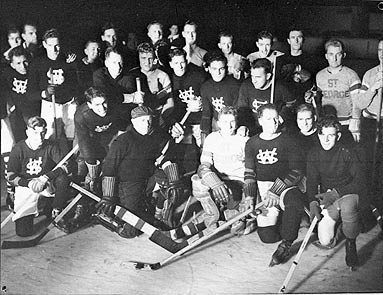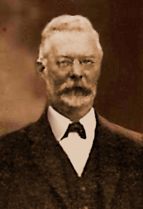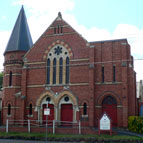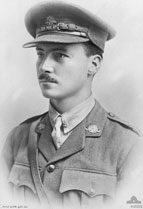Image above
(click for larger picture):
Andrew Lambert Reid (1889 - 1917), 'Andy', eldest son of Henry Newman Reid and Lucy Reid.
Portrait of Lieutenant Andrew Lambert Reid, 51st (Late 38th) Battalion, AWM145 Roll of Honour cards, 1914-1918 War, Army; Australian War Memorial Collection Image H05593 [44]
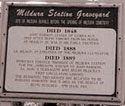
Image above
(click for larger picture):
Sign at the gravesite of Henry's brother, Andrew Lambert Reid (1866-1889). The Old Mildura Homestead is an accurate reconstruction of the first home built in Mildura in 1847. It is built on the site of the original "Mildura" pastoral lease and station. An adjoining brick building is identical to the extension added when the Chaffey family lived here. Graves nearby include those of some members of the Chaffey family.' The site includes six known graves. The sign reads: 'Mildura Station Graveyard Burials, site of Mildura burials before the opening of Mildura Cemetery...Died 1889, A L Reid A newsagent who began Mildura's first circulating library', and names the 5 others with descriptions.
'Mildura Pioneers Gravesite (The Old Mildura Homestead)', Elizabeth Jansen, 2006. [65]
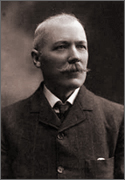 |
Image above
(click for larger picture):
Robert Reid (1842-1904), 1903, merchant and politician, uncle of Henry Newman Reid, founder of Robert Reid & Co of Melbourne, which amalgamated in 1966 with its long-time competitor Paterson, Laing & Bruce, as Paterson, Reid & Bruce.
Talma Studios, c1903, courtesy of National Library of Australia. nla.pic-an23492347.
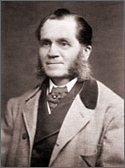
Image above:
Joseph Reed (1823? - 1890) Architect.
Thought to be the child baptized in the parish of Constantine, Cornwall, England, on 23 February 1823, son of Nicholas Reed, landowner, and his wife Amy, née Hitchins. Yet, he was connected with the family of Henry Newman Reid of Edinburgh by a cousin who married a partner of the architectural practice he founded, and another who married into the same family and was a director of Buckley & Nunn which was largely owned by Henry's uncle, Robert.
Portrait by John William Lindt, courtesy of La Trobe Picture Collection, State Library of Victoria. H4701.
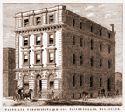
Image above:
Warne & Webster's Warehouse Flinders Lane, Melbourne, 1868. The partnership between Warne and Webster was established in Melbourne in 1866 with Robert Reid joining in 1874. The company successfully traded with its two main subsidiaries, Hustlers Pty Ltd (Inc. NSW) and Robert Reid & Co Ltd (Inc. England).
Harrison, W. H., Engraver, Date(s) of creation: September 8, 1868. State Library of Victoria
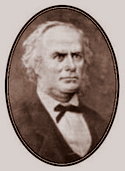
Image above:
James Harrison (? - 1893) Engineer.
His first mechanical ice-making machine begun operation in 1851 on the banks of the Barwon River at Rocky Point in Geelong. His first commercial ice-making machine followed in 1854 and his patent for an ether liquid-vapour compression refrigeration system was granted in 1855. At the Melbourne Exhibition of 1872-73, Harrison showed his proposal, where meat would be frozen in the refrigeration plant and then stored in an insulated "cold bank" on board the ship. It failed at first but his work helped in the continued development of refrigeration and it wasn't long before meat and other products were successfully transported through the tropics using it.
The James Harrison Museum committee have acquired land at Rocky Point (the site of the first ice making machine in the world) and are endeavouring to build a Museum there. The Australian Institute of Refrigeration Air Conditioning and Heating most distinguished award is the James Harrison Medal. The James Harrison bridge spanning the Barwon River in Geelong is named in his honor.
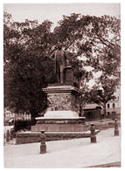
Image above:
T S Mort's Statue, Macquarie Place, Sydney, photographed about 1900-1910
Thomas Mort (1816-1878) is remembered as an Australian industrialist responsible for improving refrigeration of meat. He was renowned for speculation in the local pastoral industry as well as industrial activities such as his Ice-Works in Sydney's Darling Harbour and dry dock and engineering works at Balmain.
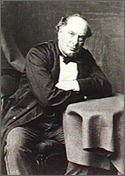
Image above:
George Selth Coppin
(1819-1906), c1890
The earliest ice-related patent on record in Australia dates back to his 1866 invention for a roller and ice skate (NAA 1866 Digital Image). Coppin was an actor and theatre owner in South Australia and Victoria and became an MP and Councillor for Richmond. He has been credited with inaugurating the second phase of development of Australian theatre by introducing the “starring tours” of visiting celebrities. He died in Richmond where Coppin Street bears his name. [20] Image held by State Library of South Australia.
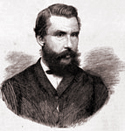
Image above:
Charles Edwin Jones (1828-1903) who in 1888, with engineer Arthur Otto Sachse (1860-1920), submitted patent specifications for 'A method of producing and maintaining an ice floor for skating and other purposes of amusement'. (NAA)
Image by unknown engraver, 1868, courtesy of La Trobe Picture Collection, State Library of Victoria.
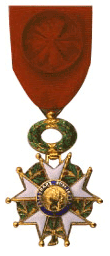
Image above:
The Légion d'honneur awarded to Henry's uncle, Robert Reid, when he was commissioner at the Paris Exhibition in 1889. The world-renowned Order was established by Napoléon Bonaparte, First Consul of the First Republic, on May 19, 1802. It is the highest decoration in France and comes with its own élite boarding schools in Saint-Denis and Les Loges in the forest of Saint-Germain-en-Laye. A thousand children and grand-children of the members of the order are educated there. Any descendants of a recipient can study there.
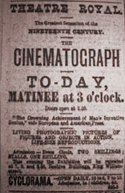
Image above:
Adelaide Advertiser advertisement, 19th October, 1896. The Adelaide Cyclorama in Hindley Street advertising it opened daily (second ad at bottom). Above it, an ad for the first documented screening of motion pictures in South Australia on Monday 19th October, 1896 at Adelaide's Theatre Royal (now demolished) directly opposite the Cyclorama. The Cyclorama became the Glaciarium Ice Palais, then a roller skating rink until T J West established The Olympia there, Adelaide's first permanent picture theatre. [63]
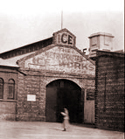
Image above:
(Click for larger image).
The Metropolitan Ice Works, Adelaide, 1922 — the ice works that supplied refrigerant to the Adelaide Glaciarium. Now the heart of Adelaide's retail precinct.
From: Central Market, Adelaide, September 28th 1922. Edwin Daw's Central Fish market and adjoining Ice Works are shown on the larger pop-up image. These buildings face west and stand approximately in the centre of acre 334. State Library of South Australia South Australiana database. Photographs of the Adelaide Ice Works are also in The Critic,
27 June 1903, page 32.

Images above:
Contemporary views of the ASO conversion of Australia's first ice rink, the 'Glaciarium Ice Palace', at 91 Hindley Street, Adelaide, 1904-5. Top image: ASO main foyer, which is probably the original 16m diameter space containing the rinks ice surface, following conversion from its original use as a 'cyclorama' (now without its original central column, seating and bandstand).

Image above:
(Click for larger image).
The Melbourne Glaciarium is the red brick building on the the right of this 1906 postcard.
'T. CRAINE'S MOTOR CAR and CARRIAGE WORKS. City Road, First Street to right over Princes Bridge next GLACIARIUM'.
Picture, State Library of Victoria, Date(s) of creation: [ca. 1906] [53]

Image above:
Australia’s first car was manufactured in Armadale in 1906, a short distance from where Reid lived. Herbert Thomson built the car at his engineering works in High Street. The original car is on display in the Melbourne Museum. (Malvern Historical Society Inc)

Image above:
(Click for larger image).
Melbourne 'Glaciarium' Interior c.1906.

Image above:
(Click for larger image).
Melbourne 'Glaciarium', c. 1950, on City Road, now occupied by Southgate. This secton of the façade, which can also be seen in the aerial photo (Fig. 2) was probably added after it first opened in 1906, by building infill of the front apron up to the City Rd carriageway alignment. Further back but out of view, the main trussed roof was much higher as shown in Fig. 3. By this time, Nicholas Pty Ltd, the Aspro people, had built the large building on the left.

Image above:
(Click for larger image).
Sydney 'Glaciarium' Interior c.1940.
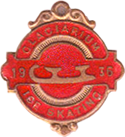
Image above:
'Glaciarium' badge, 1936, with figure skate blade. In 1921, Victoria's Ted Molony became the first player in Australia to discard figure skates for hockey tubes. They were invented in 1900.

Image above:
Main Gate of the Kent Brewery built 1835, the year Melbourne was founded, by one of the oldest brewing companies in Australia, Tooth & Co Ltd.
Henry Newman Reid worked there as a refrigeration engineer from around 1917.
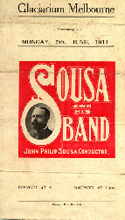 |
Image above:
'Glaciarium Melbourne commencing Monday, 5th June 1911, Sousa and His Band, John Philip Sousa, Conductor, Evenings at 8.00, Matinees at 3.00pm, Edgerton & Moore, Print., Melb.', poster.
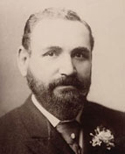
Image above:
Sir John See (1845-1907), NSW Premier at the time he was a provisional Director of the Sydney Glaciarium syndicate, South Pole Ice Rink Limited.
By unknown photographer, courtesy of State Library of New South Wales.

Image above:
(Click for larger image).
'Jimmy E. Pike [jockey], Reproduction rights owned by the State Library of Victoria.
'Snowy' Reid was Vice-President of the first NSW IHC; Sydney Glaciarium Ice Hockey Club by 1920 [2] when the President was J. Pike. In 1921, the racehorse breeder and owner James Charles Bendrodt (1891-1973) had replaced Dunbar Poole as Club Patron and Poole had replaced Jim Pike as Club President although he still remained team Captain. [2] Pike, who played the 1909 Interstate series aged 18, was among the first ice hockey players in Australia. But was 'J. Pike' James Edward (Jim) Pike (1892-1969)? Probably, which perhaps also explains Bendroft's later involvement in NSW ice hockey. Via Randwick. Jim Pike will always be remembered for his connection with the legendary Phar Lap. It seems he probably played hockey long before he rode 'Big Red'.
With Pike up for the first time, Phar Lap won the 1929 Victoria Derby in record time and they began a remarkable connection: they were together in 30 races for 27 wins including both St Legers. Pike and Phar Lap went into hiding after gunmen tried to kill the horse before the 1930 Melbourne Cup. Pike later said: 'We were never in doubt. We won as we liked'. However, weight prevented them winning the 1931 cup and Pike refused to ride the horse in the US, where Phar Lap died. Horse and jockey were the darlings of the small punters in the Depression. Pike died in poverty at his Bondi home on 7 October 1969 and was cremated with Anglican rites. His wife, son and daughter survived him.

Image above:
(Click for larger image).
'100 Years of Ice Skating' (picture), Melbourne Glaciarium, opened 9 June 1906, initialed by Beryl Black, signed by R Black, Alan Jack (?), Bill Chenell (?).
Beryl Black, Malvern East, 2006, held at State Library Victoria.
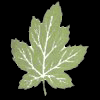
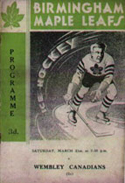
Images above:
(Click for larger image).
Birmingham Maple Leafs Logo and Programme Cover, Birmingham Maple Leafs v Wembley Canadians - 21st March 1936.
In 1935-6, Australian Ken Kennedy played for the Birmingham Maple Leafs, Birmingham, West Midlands, England, the year it won the English League Championship. The team Played in the English League Northern group in 1935-36. Home ice : Birmingham Ice Skating Rink
Team colours : white & black
Honours : Won the English League 1935-36. The league was operated as two four-team sections - Northern and Southern. The bulk of the previous seasons teams had left to form the English National League. Birmingham Maple Leafs won the Northern group, with Streatham Royals being declared winners of the Southern group, which folded around Christmas. Birmingham Maple Leafs won the single game play-off on their ice 4-2. [49]
|
GOODALL CUP
|
| 1909 Victoria 1910 Victoria 1911 New South Wales 1912 New South Wales 1913 Victoria 1914 No contest 1915 No contest 1916 No contest 1917 No contest 1918 No contest 1919 No contest 1920 No contest 1921 New South Wales 1922 Victoria 1923 New South Wales 1924 New South Wales 1925 New South Wales 1926 New South Wales 1927 New South Wales 1928 New South Wales 1929 New South Wales 1930 New South Wales 1931 New South Wales 1932 New South Wales 1933 New South Wales 1934 New South Wales 1935 New South Wales 1936 New South Wales 1937 New South Wales 1938 New South Wales 1939 New South Wales 1940 No contest 1941 No contest 1942 No contest 1943 No contest 1944 No contest 1945 No contest 1946 New South Wales 1947 Victoria 1948 New South Wales 1949 Victoria 1950 New South Wales 1951 Victoria 1952 Victoria 1953 Victoria 1954 Victoria 1955 Victoria 1956 No contest 1957 No contest 1958 No contest 1959 No contest 1960 No contest 1961 Victoria 1962 Victoria 1963 New South Wales 1964 New South Wales 1965 Victoria 1966 Victoria 1967 Victoria 1968 Victoria 1969 New South Wales 1970 New South Wales 1971 New South Wales 1972 Victoria 1973 Victoria 1974 Victoria 1975 Victoria 1976 Victoria 1977 Queensland 1978 Victoria 1979 Victoria 1980 New South Wales 1981 New South Wales 1982 Victoria 1983 New South Wales 1984 New South Wales 1985 New South Wales 1986 South Australia 1987 South Australia 1988 New South Wales 1989 New South Wales 1990 South Australia 1991 No contest 1992 New South Wales 1993 New South Wales 1994 New South Wales 1995 South Australia 1996 New South Wales 1997 New South Wales 1998 ACT 1999 New South Wales 2000 New South Wales 2001 Sydney Bears 2002 Adelaide Avalanche 2003 Newcastle North Stars 2004 Western Sydney 2005 Newcastle North Stars 2006 Newcastle North Stars 2007 Penrith Bears |
|
EAST COAST SUPERLEAGUE NSW
|
| 1984 Warringah Bombers 1988 Canberra Knights 1989 Macquarie Bears 1990 Macquarie Bears 1991 Warringah Bombers 1992 Warringah Bombers 1993 Macquarie Bears 1994 Macquarie Bears 1995 Warringah Bombers 1996 Canterbury Eagles 1997 Macquarie Bears |
|
NATIONAL CLUB CHAMPIONS
|
| 1955 Blackhawks, Melbourne 1962 Glebe Lions, Sydney 1963 Hakoah, Melbourne 1964 St George, Sydney 1965 Blackhawks, Melbourne 1966 Glebe Lions, Sydney 1967 Monarchs, Melbourne 1968 Monarchs, Melbourne 1969 Monarchs, Melbourne 1970 Monarchs, Melbourne 1971 St George, Sydney 1972 Monarchs, Melbourne 1973 Monarchs, Melbourne 1974 Hakoah, Melbourne 1975 Glebe Lions, Sydney 1976 C'bury United, Sydney |
|
NSW LEAGUE
|
| 1984 Warringah Bombers 1988 Canberra Knights 1989 Macquarie Bears 1990 Macquarie Bears 1991 Warringah Bombers 1992 Warringah Bombers 1993 Macquarie Bears 1994 Macquarie Bears 1995 Warringah Bombers 1996 Canterbury Eagles 1997 Macquarie Bears 1998 1999 Sydney Bears 2000 2001 Blacktown Flyers |
|
VICTORIAN LEAGUE
|
| 1909 Melburnians 1910 Melburnians 1911 Melburnians 1912 Melburnians 1913 Melburnians 1914 Contest Abandoned 1915 No contest 1916 No contest 1917 No contest 1918 No contest 1919 No contest 1920 No contest 1921 Yukon 1922 Melbourne 1923 Melbourne 1924 Essendon 1925 Essendon 1926 Essendon 1927 Brighton 1928 Essendon 1929 Brighton 1930 Hawthorn 1931 Essendon 1932 Essendon 1933 Essendon 1934 Brighton 1935 Essendon 1936 Hawthorn 1937 Hawthorn 1938 Hawthorn 1939 Bombers 1940 Bombers 1941 No contest 1942 No contest 1943 No contest 1944 No contest 1945 No contest 1946 Western Suburbs 1947 Blackhawks 1948 Monarchs 1949 Tigers 1950 Tigers 1951 Raiders 1952 Raiders 1953 Raiders 1954 Raiders 1955 Blackhawks 1956 Blackhawks 1957 Blackhawks 1958 Blackhawks 1959 Monarchs 1960 Blackhawks 1961 Monarchs 1962 Monarchs 1963 Hakoah 1964 Hakoah 1965 Blackhawks 1966 Blackhawks 1967 Monarchs 1968 Monarchs 1969 Monarchs 1970 Demons 1971 Hakoah 1972 Monarchs 1973 Monarchs 1974 Hakoah 1975 Rangers 1976 Pirates 1977 Demons 1978 Pirates 1979 Rangers 1980 Hakoah 1981 Rangers 1982 Rangers 1983 Saints/Monarchs 1984 Blackhawks 1985 Pirates 1986 Saints/Monarchs 1987 Saints/Monarchs 1988 Saints/Monarchs 1989 Saints/Monarchs 1990 Saints/Monarchs 1991 Saints/Monarchs 1992 Saints/Monarchs 1993 Saints/Monarchs 1994 Saints/Monarchs 1995 Jets 1996 Saints/Monarchs 1997 Demons 1998 Demons 1999 Demons 2000 Demons 2001 Victoria 2002 2003 2004 Sharks 2005 Blackhawks 2006 Blackhawks 2007 Braves |
|
MVP 1966-2000
|
| 1966 B. Beattie VIC 1967 R. Joslin VIC 1968 J. Christie VIC 1969 J. Bend NSW 1970 R. Suran VIC 1971 B. Smale VIC 1972 R. Stevenson VIC 1973 R. Stevenson VIC 1974 J. Christie VIC 1975 G. Kenning NSW 1976 I. Holmes VIC 1977 D. Waymarch QLD 1978 P. Vlaciky NSW 1979 R. Nordon VIC 1980 R. Brideau NSW 1981 R. Mac Eachern VIC 1982 P. Corrado QLD 1983 G. Grant WA 1984 K. Dolighan VIC 1985 C. Hutchinson WA 1986 S. Davidson VIC 1987 R. Black VIC 1988 A. Malste SA 1989 A. Malste SA 1990 C. Naish ACT 1991 Pekka Uusi-Hakimo SA 1992 A. McLean ACT 1993 NOT HELD 1994 H. Jones NSW 1995 C. Rurak SA 1996 G. Foll SA 1997 V. Rubes NSW 1998 ? 1999 T. Lovering NSW 2000 L. Harrow ACT |

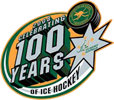
Refrigeration and Consulting Engineer
Founder of Ice Hockey in Australia, 1906-8
Founder — Melbourne Ice Skating & Refrigeration Co, 1906 or earlier
Head — Adelaide and Melbourne Glaciarium Syndicates (1903-1906)
Henry Newman Reid was the pioneer of national ice sports and founder of ice hockey in Australia. He was the leader of an entrepreneurial syndicate that established Australia's first ice rink in 1904 at 91 Hindley Street, Adelaide, the western continuation of Rundle Mall (pictured below and left). His syndicates went on to build the first ice rinks in Melbourne in 1906, at South Gate, and in Sydney in 1907, at Railway Square, Haymarket. Reid's world-class facilities for figure skating, speed skating and ice hockey were built with venture capital over a century ago and produced the first two generations of National ice champions, including his own son and daughter, and many others who represented Australia at Olympic and World Championships. The Melbourne and Sydney Glaciariums were the first and only Australian rinks for 30 years and the Melbourne rink that Reid initially managed himself cradled the birth of national ice hockey competition, and the national organising bodies for both ice hockey (1908) and skating (1911). The Melbourne Glaciarium is also the story of the first permanent moving picture palace and the birth of the silent film era in Australia.
Henry Reid was the second son of Rev. John Lambert Reid M.A. (1831-1911) and Mary Ann Mireylees (1831-1918) of Edinburgh. [4, 28, 29, 56] His father was the eldest child of Robert Reid (1808-1855), bookseller and printer, and Catherine Lambert born at the seaport of Scoonie at Leven in Fife, Scotland on October 18th, 1831. His family immigrated to Melbourne on April 7th, 1855 aboard 'Ralph Waller'. [66] John and Mary Ann remained in Britain until ten years later, having married the year prior when they were both 24 years old. John's father, Robert, died six weeks after the family arrived in Melbourne and his brother, Robert Reid (1842-1904), found himself supporting his mother and six sisters from the age of 13.
Within ten years, Robert had purchased a cottage and land in Punt Road, Richmond for his mother, paying £111 17/- in June 1864 to Revett Henry Bland, director of the National Bank. Robert married Mary Jane Clancy there on February 2nd, 1865 at the age of 23. They lived at 'Belmont' in Balwyn, a large estate bounded north by Whitehorse Road and south by Mont Albert Road, after which Belmont Park and Belmont Avenue near Camberwell Grammar were later named. Their youngest daughter, Belle Reid (1883-1945), developed her interest in animals from the district's market gardens and dairies. She became the first formally recognized female veterinary surgeon in the British Empire in 1906 and later established the 1,000 acre farm 'Blossom Park' in Bundoora with her sister 'May' (Mary). Belle was inducted to the National Pioneer Women's Hall of Fame in 1996 and the University of Melbourne established the Belle Bruce Reid Medal in 2006.
Henry's father, John, finished his education at the University of Edinburgh and became a Congregationalist preacher and Lecturer on Theology and Philosophy. [69] According to his daughter Agnes and others, he was a learned man; a Shakespearean Scholar who spoke several languages, a founder and secretary of the Melbourne Shakespeare Society, and chairman of the Baptist Union of Victoria in 1877. [68] Henry's mother, Mary Ann was also born in Edinburgh, descended from Robert Mireylees (~1780- ) and Euphemia Dunbar who married in Edinburgh on March 15th, 1799. With the aid of DNA testing, this branch of the Mirilees family has traced its ancestry back four centuries to James Mirrileyis born about 1610, a blacksmith of Pencaitland, East Lothian, who married Elspeth Blair in Ormiston in 1641, about 30 miles east of Edinburgh in the Dunbar Area of East Lothian. [56]
John and Mary were married on May 3rd, 1854 at Dundee, Scotland. [4] Early in 1864, they emigrated from Liverpool on 'Empress of the Sea', a Black Ball Line clipper built the year prior. 'Empress' was about the same length and two-thirds the width of 'Polly Woodside'. They arrived at Port Phillip (Melbourne) in June that year with their young family: William Eliot, aged 6; Mary Anne, aged 4, Louisa, aged 3; Henry Newman himself, aged 2; and baby Agnes. [29] John was minister at the East St Kilda Congregational Church (pictured left), corner Hotham and Inkerman Streets, first established in 1865. The present Church was built in 1887 from which time Henry's younger brothers and sisters lived in the manse.
Five more children were born in Victoria between 1864-73: John in 1864 who died an infant in 1865; Alison in 1868; Edith in 1869; Edward Crichton in 1872, and Kezia McCallum in 1873. Another son, Andrew Lambert, was born in 1866 but died in 1889, just 23 years of age. [4, 10, 65] He was a newsagent who began Mildura's first circulating library and was buried on the original "Mildura" pastoral lease and station established 1847, now The Old Mildura Homestead. [65] Henry's first son, born the year his brother Andrew died, was possibly named in his memory. By 1890, Henry Reid had six sisters and two surviving brothers named William Eliot Reid and Edward Crichton Reid. [4, 10]
Some histories incorrectly place Henry Newman Reid's arrival in Australia about 1894. [1, 2] In fact, he arrived as a child some 30 years earlier and he had lived in Melbourne for 39 years before he formed the Adelaide 'Glaciarium' syndicate in 1903. He was already firmly established in business circles as a refrigeration engineer and he and wife, Lucy, were raising four children of their own. Henry's parents, aunts and uncle had immigrated 9 years earlier in 1855. By the time Henry was 18, his extended family had history in Melbourne stretching back 35 years and the Reid family name was already firmly established through his uncle, Robert, who had set up Warne & Reid at Collingwood, forerunner to Robert Reid & Co, one of the largest importing busineses in Australia. Its head office was in London by the 1890s with branches in Glasgow, Sydney, Adelaide and Brisbane. Buyers from its London and Glasgow branches combed Europe for softgoods to export to Australia.
Robert was also a major share holder in Buckley & Nunn, the Melbourne department store established in 1851 with as fine a reputation as David Jones and Myer. He had four sons and six daughters, two of whom married Bates brothers. Agnes Ethel Reid married Edward Albert Bates in Victoria in 1897 [61] and lived at "Mileela". Edward was a partner with Bates Smart, Australia's oldest architectural firm — one of the world's oldest — first established in 1853 by Joseph Reed (1823?-1890, pictured left) as Reed and Barnes. Catherine Lambert Reid married William Edward Copeland Bates in 1892 in Victoria [61] and lived at "Larino", both becaming directors of Robert Reid & Co and Buckley & Nunn in 1893. The department store is now David Jones next to Myer at 310 Bourke Street, Melbourne, designed by Bates Smart McCutcheon in 1934. [58] The Bates' Balwyn estate, 'Larino', became the 'Frances Barkman Home' after Frances Barkman (1885-1946) initiated a home for thirty-two Jewish refugee children there in 1939.
 |
| Department stores in the 1920s turned shopping into a popular leisure activity for women. Passers-by were enticed by tantalising window displays. Cafeteria dining completed the 'day out'. Bourke Street became the department store hub and still is. Myer, Buckley and Nunn, Foy & Gibson, Paynes Bon Marche and Hicks, Atkinson and Sons were all within a short distance of each other. (Source: State Library of Victoria) |
The first generation of Reid's family arrived in Melbourne just 20 years after it was founded. Back in Scotland, Robert Reid had uncles named John, a merchant with ties to South America and Alexander, a master gardener in Angus (Fife). In an 1899 Table Talk interview [59] he revealed one such uncle spoke of a great-uncle also named Robert who had arrived in Australia very much earlier:
"The name of Robert has been long in the family. When at home on his last visit to Scotland, the subject of this biography (Robert) was talking with his uncle, an old man of 86, who said to him, “Your mither’ll no ken wha your’re c’ad after,” and proceeded to relate how Mr. Reid’s great-uncle, Robert Reid, after whom his father had been named, was a bold, buccaneering sort of a character, who ran away from home and joining service with Captain Cook, was present at the planting of the British flag in New South Wales in 1787. To which the grand-nephew replied that he wished his relatives had told him of his wild, freebooting great-uncle on his former visit to Scotland three years before, as he had since been present at the Australian Centennial Banquet of 1887, when the story then and there told would have some point of interest.
“I feel quite as proud of being descended from such a man,” said Mr Reid to his old uncle, “as English people do, who date their origin from the coming over to their island of that Norman Robber, William the Conqueror,” which sentiments surprised the octogenarian much, as he had been designating the Robert Reid of 1787 a “blackguard and a ne’ar-do-well,” but his great-nephew maintains that it is men of such adventurous and intrepid spirit who have made the British Empire what it is, and have laid the foundation of a future colonial aristocracy (the latter used in the best sense of the word) will look back with pride to their brave and glorious forefathers, the first planters of the British Standard on this great Australian Continent, and with it established British speech, laws, energy and enterprise on this side of the globe, all which are fast developing a great southern nation, full of large possibilities and potent influences in the subsequent history of the world." [59]
Captain James Cook (1728-1779) was the son of a Scottish farm labourer and a Yorkshire girl, not rich or noble parents like most Naval officers of the time. He made three voyages to Australia: 'Endeavour' 1768-71, 'Resolution' 1772-5 and 1776-80. Later, the First Fleet under Captain Arthur Phillip left England on May 13th, 1787 arriving at Botany Bay between January 18th and 20th, 1788. On the 26th, with the entire fleet anchored in Port Jackson, the British flag was raised and Governor Phillip took formal possession of New South Wales. Robert Reid is said to have sailed with Cook, not Phillip, although he could have returned to England then made a subsequent voyage. He is not listed among 'Endeavour' crew nor First Fleet convicts. He could have been among 'Resolution' crew on Cook's 2nd or 3rd voyages or one of 200 sailors, marines and officers who sailed with the First Fleet.
Many 'First Fleeters' were buried at the Old Sydney Burial Ground from 1792 to 1820 and, indeed, a Robert Reed was buried there on October 31st, 1813, aged 50. He was born about 1763 and came Free. 'Reid' and 'Reed' were interchangeable and records of age at death are not always reliable. Nonetheless, the story has it Robert's great-uncle ran away from home as a boy, and the Robert in this grave was aged between 10 and 13 years when Cook sailed his last two voyages. The story may well be true and this is possibly the last resting place of Henry Newman Reid's great-great-uncle, who had sailed with Cook as a boy and at age 25 'was present at the planting of the British flag in New South Wales in 1787' (actually January 26th, 1788). [60]
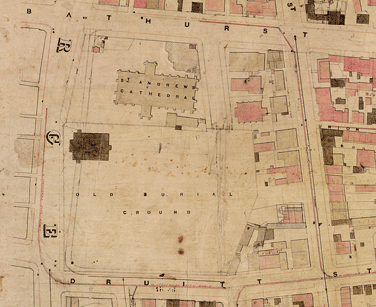 |
| Old Burial Ground, 1865. Detail from the Trigonometrical Survey of Sydney showing the Old Burial Ground and St Andrews Cathedral. Sydney Council was granted the land for a Town Hall shortly afterwards. (Source Detail from Sheet E1, Trigonometrical Survey of Sydney 1865. City of Sydney Archives / State Records) |
Reid was also an Associate of the Institute of Engineers Australia, formed in 1919. [34] Some think he specialised in valves and temperature controls and applied for several patents. [2] By the time he was choosing a career, the natural ice industry had become big business in the US and Europe, where ice was cut from the lakes in winter and stored during the summer for export. By 1890, the US alone was exporting 25 million tons. There was none to harvest in Australia, except in Hobart where it was used for the first water supply, and it was very costly to keep food cool. Refrigeration was one of the great engineering achievements of the 19th century and that was nowhere more heartfelt than in the Australian climate. As it happened, Reid was already at the forefront of refrigeration technology. It had been pioneered by another Scot at Geelong near Melbourne, around the time that Reid was born.
In 1837, a journalist named James Harrison (pictured left) moved to Geelong from Glasgow and set about designing a refrigeration machine. By 1851 he had a working prototype and, typical of Australian priorities, was soon commissioned by a brewery to cool beer. The result was the first ever practical use of a refrigeration machine producing 3000kg of ice per day. Meanwhile, in Sydney, Thomas Sutcliffe Mort (1816-1878, pictured left) was financing experiments by Eugene Dominic Nicolle, a French-born engineer who registered his first ice-making patent at Sydney in 1861. Mort established the first freezing works in the world that year at Darling Harbour, later known as the NSW Fresh Food and Ice Company.
In 1885, Joseph Fishburn applied for the first Australian ice rink patent on record entitled 'Improvements in and relating to ice rinks". [17] Then in 1888, the year of the International Exhibition in Melbourne, the engineer Arthur Otto Sachse (1860-1920) and land agent Charles Edwin Jones (1828-1903) submitted specifications for 'A method of producing and maintaining an ice floor for skating and other purposes of amusement'. [16] Sachse was a mechanical engineer born in Toowoomba, Queensland, who had settled in Melbourne in 1885, practising as a consulting engineer, patents and trade marks attorney and importer. He was also an MP, a director of the Metropolitan Gas Co, and a University of Melbourne councillor from 1905. A contemporary of Reid, both men married the same year. Sachse had patented hundreds of inventions and other oddities by the time of his death at South Yarra in 1920, many on behalf of others. [18]
His patent partner, Jones, (pictured left) was an MP, Melbourne city councillor, journalist and owner of the lively People's Tribune newspaper (1883-6), who became a land agent in the speculative boom of the 1880s. He left for WA soon after the Patent application, returning to Ballarat in 1901. He died at Korumburra in 1903, about the time Reid formed his Glaciarium syndicate. [19]
Reid may have been associated with the 1888 Melbourne ice rink patent although Sachse was a qualified mechanical engineer who could have devised improvements for ice rinks independently. Sachse's patent partner had died in 1903, the year Reid formed his syndicate, and the pair may have come to some arrangement. In any event, no similar applications were made until 1896 in Sydney, when Charles Arthur MacDonald successfully applied to the NSW Department of Justice to patent an invention entitled 'An improved ice skating rink'. That appears to have been an improvement to the method Sachse had patented 8 years earlier in Melbourne. MacDonald's patent process continued until 1904 (NAA 1896 Digital Image). [15] In 1907, Henry Newman Reid, trading as the Melbourne Ice Skating & Refrigeration Co, challenged MacDonald's patent, perhaps in relation to the Sydney 'Glaciarium' that had opened the same year. [14] The case was heard before the Full Court of the High Court of Australia, where two or more Justices presided. Of several hundred patents related to ice making in the National Archives, these are the few directly related to ice rinks. Reid had appealed MacDonald's improved ice floor patent in the High Court, as if his own rights or patents had somehow been restricted or breached.
Henry Reid married Lucy Marsden [27] in Melbourne in 1888, the year the 'ice floor' patent was registered there by Sachse. The couple had four children in Melbourne between 1889-96: Andrew Lambert Newman, born 21 September 1889 at Hawksburn; Henry Newman Jr., born 1891; Leslie Herbert, born Jan 1894 at Brighton, Victoria; and Lucy Merrilees, born 1896. [10, 37] Donald McKnight wrote recently "... Reid had three sons who all played ice hockey albeit in figure skates..." [13] and Sid Tange named Reid's children as Hal, Andy, Les (Snowy) and a daughter, Merrilees:
"The advertisement below announces that a "Great Ice Hockey Match" would be played on Wednesday October 12, 1904. Names of the players are not known, but four of them would have been Mr Newman Reid's sons; Hal, Andy, Les (Snowy) and Dunbar Poole." [2]
At that time, Henry Sr was aged about 42; Andy was aged 15, Hal (Henry Jr) was aged 13; and Leslie was aged 10. After Hawksburn (c.1889) and Brighton (c.1894), the Reid family home was 'Locksley', Haverbrack Ave, Malvern; off Glenferrie Rd near the Malvern Town Hall. The first allotments in Haverbrack Avenue were in the second plan of land subdivision in Malvern, sold by agents Munro & Baillieu in 1890. Malvern Central School, the oldest school in the district, was established in 1875 in Spring Road at the end of Haverbrack Ave. Prior to 1875 classes were held in the old courthouse and the schoolhouse at St George’s Church. Reid and Lucy raised their family deep in the heartland of the Melburnian middle classes. Sir Robert Menzies (1894-1978), former Australian Prime Minister and founder of the Australian Liberal Party, lived at No 2 Haverbrack Ave from 1966-78 and Malvern was home to many other notable Australians of Reid's time.
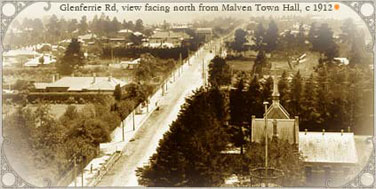 |
| The Reid family neighbourhood c. 1912. View looking north along Glenferrie Road from the Malvern Town Hall towards Malvern Road and beyond. The second tower of the Town Hall and St George's Church and Sunday School are in the foreground, beneath which is Malvern Cricket Ground. Reid's home, 'Locksley' in Haverbrack Ave is beyond them, second street on the right, off Glenferrie Rd. (Malvern Historical Society Inc) |
Reid formed the 'Glaciarium' syndicate about 1903 with Dunbar Poole (1877-1954) and others. Reid's uncle, Robert, was 'a foremost Australian commercial magnate', and spent a good deal of time at his London headquarters. He was president of the first Congress of the Chambers of Commerce in Australasia during Victoria's centennial exhibition. He had represented the Melbourne Chamber of Commerce at the Indian and Colonial Exhibition (1886) in London and he was a commissioner at the Paris Exhibition (1889) when he received the cross of the Légion d'honneur [pictured left]. In the years preceding his nephew's rink syndicates, Robert was president of the Melbourne chamber in 1888-90 and 1899-1902, and a member of the upper house (Senate) of the Victorian ministry from 1892 until he resigned in February 1903, the year before he died. He had held defence, health and public instruction portfolios.
Although Robert refused the position of agent-general in London through pressure of business, the government charged him with explaining the colonial financial situation to help to restore credit there. Robert Reid also persuaded London shippers of the importance of refrigeration, before returning through North America. [57] Amongst his commitments there, he gave a lecture in 1893 at Vancouver, British Columbia, as the Honorable Robert Reid, Minister for Defence and Health from the Colony of Victoria Australia. [58] Vancouver was quite small at the time but it was also one of the fastest growing Canadian cities. So, as it happened, Robert visited Canada on official government business, promoting shipping refrigeration in London en route, just ten years before Henry set up the first ice rink syndicate.
Canada was most famous for one thing in 1893. The year before, the Governor General of Canada, Lord Stanley of Preston, recognised there was no trophy for the best ice hockey team there and purchased a decorative bowl for that purpose. In 1893, there were almost a hundred teams in Montreal alone, and leagues throughout Canada. The donated cup became the world's first ice hockey trophy that year, the Dominion Hockey Challenge Cup, now more famously known as the Stanley Cup. On a diplomatic mission for Australia, Robert Reid was quite possibly received by the Governor-General, Lord Stanley, and the occasion may well have been a definitive moment in the rink development plans of Reid's nephew Henry. Henry was well-connected to both Melbourne business and State politics through Robert, but it didn't stop there. Robert was a leading Australian commercial magnate with headquarters in London; a branch office in Glasgow from where Henry's associate Dubar Poole migrated in 1899; and branches in the three States in which ice rinks were proposed; Adelaide, Melbourne and Sydney.
The Reid-Mirilees and Poole family lines both appear to have distantly originated from the Dunbar area of East Lothien, Scotland. They may well have been known to each other and Henry had the means to come and go from Britain at will. His uncle was constantly shipping between Britain and Australia and had done so for years. Those were the circumstances in which the two men met when Poole arrived in Melbourne late-1899, three or four years before Reid formed the Adelaide syndicate. Poole was in his early 20s and Reid was 15 years his senior and very influential. Russell has said that:
'In 1903, Poole sailed from Glasgow to Australia on a windjammer. It is written that, after a stormy voyage of 112 days, the ship finally berthed in Adelaide and there, he found something quite unexpected — a group of ice skating enthusiasts.' [46]
'Loch Garry' did dock at Port Philip (Melbourne) in October of that year with eight aboard including Captain and crew, but Poole was not among them. He may have boarded at Melbourne to travel to Adelaide like other members of the syndicate that year. However, he immigrated on an earlier 'Loch Garry' voyage that arrived at Port Philip in September 1899 with 15 others. [47, 48] He left Glasgow about May, 1899 and arrived in Melbourne the following September. 'Loch Garry' was a 1,565 ton, three masted ship owned by the Loch Line, formerly the Glasgow Shipping Co. The usual route was to load general cargo and passengers at Glasgow, sail to Adelaide, then to Melbourne or Sydney where they loaded wool or grain, generally for London. The company never changed to steamships, persisting with sail, and consistently ran at a financial loss from 1900. Passengers generally preferred the speed and comfort of steamers and freight rates dropped. The 'Loch' ships usually managed one round voyage to Australia per year and half of this time was unprofitably spent in port, loading, unloading or waiting for cargoes.
Reid had llived in Melbourne a long time yet his rink syndicates were comprised mainly of Scots from Glasgow and Edinburgh. Poole presumably had good reason to leave Britain, particularly given he was reputedly Britain's best ice rink manager. [2, 46] There were no indoor rinks in Scotland until 10 years after he left, nor any in Australia, and so it seems more probable that the syndicate had lured him there for his expertise. They needed someone capable and there was a good prospect of Poole profiting from the first indoor rinks in Australia. Reid's connections to Glasgow and London through his uncle suggest Poole's arrival was more than just happenstance; he was in the loop.
Ice rinks were, and still are, more dependent on patronage for commercial survival than most other sports facilities. The bigger their catchment population, the more likely they are to be financially viable. London had an enormous population of 6.5 million in 1900, with most of the modern conveniences we have today — electric light and gas heating, an extensive telephone network, an extensive underground railway network, buses and taxis, a national postal service and metropolitan police force. It could viably support multiple ice rinks and did. On the other hand, Glasgow and Edinburgh, the leading cities of Scotland, had been locked into rivalries since at least the eighteenth century. Edinburgh’s population in 1901 was a mere 300,000 or so. It had a reputation at the turn of the century as a staid, climatically bracing, Presbyterian and puritanical city, bristling with well-frequented churches, and peopled with ministers, lawyers, academics and doctors. Glasgow was the opposite. It had a population of over 750,000, drawn both from Ireland and the West of Scotland, as it expanded to become ‘the second city of the Empire’, through industry based on coal, iron, textiles and later shipbuilding.
Melbourne's population after 1880 doubled in 10 years — the 'Marvellous Melbourne' era. Its streets were first lit by electric lighting in 1894 and the first part of the mains sewage system became operational in 1897. Electric trams arrived in 1905, in addition to cable-drawn trams that had existed since 1885. The city had long had good postal and telegraph services and the first telephone services in Australia had been established there in 1879. It had hosted Test Matches and International Exhibitions and was home to world-class exhibition centres, museums, galleries, libraries, courts and schools. Ornate office buildings up to 12 storeys high rivalled those of New York, London and Chicago. While Sydney was seen as slow and steady, Melbourne was fast and reckless. An ice rink was one of the few things it didn't have.
By 1891 the high times were coming to an end. Banks closed their doors, stockbrokers panicked and thousands lost jobs, homes and savings. Some escaped unscathed but many were plunged into hardship. It was a dramatic fall, and a far more sober and cautious Melbourne faced the new century. When Poole arrived on the eve of the new century, over half a million people were living there and the State itself was home to 1.2 million. In fact, Victoria in 1900 was more populous than Glasgow and Edinburgh combined and Melbourne had created itself in a short 65 years to become the most Victorian city outside London itself. It was and always had been a speculative city, a business enterprise, but Sydney was also growing, exceeding Melbourne's population for the first time in 1902.
Adelaide, on the other hand, had only just become a state capital. With a population of only 160,000 people, it was one-third the size of Melbourne and Sydney. However, it was there that Reid decided to start, choosing the Adelaide Cyclorama (1890-99) [31] in Hindley St, by architects English & Soward, for his first rink. Cycloramas contained a large picture painted onto a cylindrical wall, designed so that it was seen in natural perspective from a platform on which the viewer stood. They were first executed by Robert Barker, an Edinburgh artist, who exhibited one there in 1788. Reed & Gross of Chicago were first to introduce them to Australia in Collins Street, Melbourne, on the site of Georges, 'the store on the hill', built later in 1913, and Sydney. 'Waterloo' was presented in Melbourne and 'The Battle of Gettysburg' in Sydney.
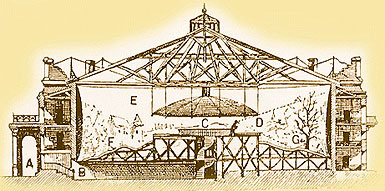 |
| Cross-section through the Cyclorama at Altotting, Germany. The umbrella shape over the platform is a skydome which added to the illusion of false perspective by cropping the view (interior below). |
The huge painting in the Adelaide Cyclorama was a set-painted copy of ‘Jerusalem and the Crucifixion of Christ’ (1903) by Bruno Piglhein of Munich. It was probably painted by Thaddeus Welch (1844- ) among others, a california landscape painter who studied at the Royal Academy of Art in Munich where he may have met Piglhein. Back in the US, he and other artists painted a cyclorama of the 'Battle of Gettysburg' (1887, Illinois), 'The Siege of Paris' and 'Jerusalem on the Day of the Crucifixion' (1888) before signing a contract to paint cycloramas in Australia in 1889 which no doubt included the Adelaide panorama. He was next hired by Reed and Gross, the company who first introduced Cycloramas to Australia. [64] The Glasgow company Fishburn Brothers held the exhibition rights to Piglhein's panorama and they won a court case preventing it from being exhibited. Manning [31] mentions the hall in which the picture was hung was 39.6m by 35m by 14.6m high and roofed in a single span. It was lit by a central glass skylight.
The Adelaide Cyclorama was destroyed by fire in March 1899, nine years after it opened — about the time a panorama with the same name as its own was acquired by Acme Investment Company, owners of London's National Skating Palace between 1902-8. [62] The 'Palace' was also known as 'Hengler's' after its developer, circus proprietor Charles Hengler (1820–1887) who staged circuses in his permanent theatres in Liverpool (1857) and Glasgow (1867) before his London débute in 1865. Unsuccessful in London at first, he somehow acquired the Palais Royal six years later and converted it into an 'elegant theatre' known as Hengler's Circus. It became the National Skating Palace in 1895, and eventually the London Palladium. The first British Ice Figure and Dance Championship on record was at 'Hengler's' in 1902, the Ladies gold won by Madge Sayers. The Championships were held at 'Princes' thereafter. Adelaide's huge painting may have been spared the fire by the Glasgow company's landmark court case and Reid's syndicate may somehow have been associated with Hengler's — London's National Skating Palace.
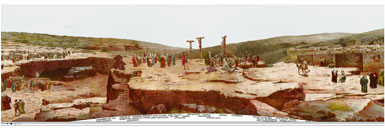 |
| Small section of the panorama ‘Jerusalem and the Crucifixion of Christ’ by Bruno Piglhein of Munich, displayed in the Adelaide Cyclorama and possibly London's National Skating Palace (1895-1899) soon after it closed. The full panorama is viewable in Quicktime at this link. Pan the image by moving the mouse over it left and right. Zoom in and out with the Shift and Control keys. (Site on Bruno Piglheim, creator of the panorama, website by his great grandson). |
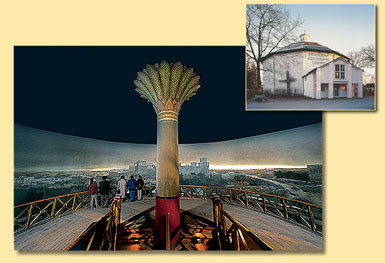 |
| The panorama installation at Altotting, Germany, by Gebhard Fugel. |
By 1904, Reid's syndicate had acquired the Adelaide Cyclorama or rather, whatever had survived the fire and been rebuilt. Reid may not have used architects but if he did, he need have looked no farther than his own family. Edward Bates, who married Henry's niece Agnes, was a partner with Melbourne's Bates, Peebles & Smart, the firm evolved from the practice of Joseph Reed, architect of the State Library of Victoria (1854), Melbourne Town Hall (1867), Scot's Church (1867) and Royal Exhibition Building (1880). The first Parliament of Australia was opened a few years earlier at the Royal Exhibition Building; the first building in Australia awarded UNESCO World Heritage. BPS had just finished Central Hall (1903) in Brunswick St, Fitzroy and by 1905 construction began on their Melba Hall in Royal Parade for the University of Melbourne. Immediately after the rink was built, Edward Bates worked with civil engineer Sir John Monash on the family's Robert Reid & Co. warehouse in Flinders St (1907-8) built by C. Langford and Monash was designing St Peter's College Baths in Adelaide late-1906; the school that Reid's sons attended when the family moved there to build the Glaciarium. In 1911, PSB and Monash designed the Buckley & Nunn warehouse, now part of the David Jones department store, directed by the Reid's and Bates who were major shareholders.[70]
The Glaciarium proposal was reported in Adelaide's Advertiser, Register and Express newspapers from June 1904 until 31 May 1905. According to Ice Skating Australia, the Advertiser reported Australia's first rink opened Tuesday, September 6th, 1904. It was named the 'Glaciarium Ice Palace'. The Advertiser also reported the rink had electric lighting and seating for 3,000 people (equivalent to the Palais Theatre in Melbourne). [13, 41] The earliest newspaper records of an 'ice hockey' match are dated July 5th and 12th, 1905, in the Adelaide Express and Advertiser. A 'hockey' match on an ice skating rink was also reported in the Advertiser (14 Aug 1905, p. 6e) and in various subsequent newspapers on numerous occasions. [41]
Reid's uncle Robert was holidaying in England in the early part of 1904. He died there at the age of 61 on May 12th, 1904 at St Ermins Hotel, Westminster, four months before the Adelaide rink opened. He was buried on May 16th at Hampstead Cemetery, Fortune Green Road, four miles from the centre of London. Hampstead's magnificent views and health-giving springs brought it many famous inhabitants and visitors over the years including John Constable, William Blake, Alfred Tennyson, Anna Pavlova, and George Du Maurier. One of the most impressive graves belongs to Bannister Fletcher, who wrote the manual for architects. Henry was now without his uncle, but Robert's sons and daughter successfully continued the family importing business long after his death.
Charles Hengler was about 20 years older than Robert and he had been buried at the same cemetery 17 years earlier, adding interest to a possible association. Perhaps they shared a common interest in London's Acme Investment Company and their cyclorama which Reid could easily have shipped. Or perhaps through Dunbar Poole, reputedly Britain's top rink manager, who could have worked at the National Skating Palace some time during the decade it operated until he emigrated. One of Hengler's touring circuses performed at the circus site near where Melbourne's Glaciarium was later built, and one of his ringmasters, George Benjamin William Lewis (1818-1906), migrated to Melbourne late-1853 after touring Europe with Hengler in 1849-51. Lewis set up Astley's Amphitheatre in Spring Street for equestrian drama and circus. Modeled on it's 1773 namesake in London it was forerunner to Melbourne's first Princess Theatre. Lewis toured the goldfields with his circus, China in 1859 and back in Melbourne, the troupe appeared at Cremorne Gardens, Australia's first amusement park (1853-63), owned by George Selth Coppin (1819-1906, pictured left) who patented his ice skate invention a few years later in 1866.
This park also happened to have a Cyclorama and it was virtually next door to the Punt Road residence where Robert Reid and his mother lived at the time. Henry's father, John, and Coppin shared a friend in common, theatre critic James Edward Neild (1824-1906). John, Nield and others read the 'Merchant of Venice' for charity at "Crofton Hurst," Hawthorn Road, Caulfield, one Friday evening in 1893. [71] Like John, Nield was a founder of the Melbourne Shakespeare Society and president in 1890, the year in which Coppin had presided over a public testimonial for him at the Princess Theatre, in recognition of his many public services. Nield was also a member of a Bohemian clique that included Marcus Clarke, G. G. McCrae, Dr Patrick Moloney, 'Orion' Horne, J. J. Shillinglaw, Henry Kendall and Adam Lindsay Gordon. These and many actors and artists gathered at his home at 21 Spring Street, Melbourne regularly on Sunday afternoons. All were members of the Yorick Club, the only significant centre of literary interest and achievement in Victoria in the late 1860s and 1870s, that met Saturday nights at Frederick Hadden's home in Spring St. Some of the early 'circus' developments like Lewis' Astley's Amphitheatre, were more variety, picture and music hall theatres to which the first Australian ice rinks were closely related, and probably by more than just ideas. They traversed continents, precursors to the ice shows in which Dunbar Poole developed his abilities.
The first rink was over 8,000 super-feet of real ice (743 m2). [1, 41] It's ice surface was circular like the space it was in, with a radius of about 15.4m given its area. Its diameter was therefore about 31m but, strangely, it had a central column with a bandstand for public skating sessions, surrounded by upholstered seats on which skaters could rest, all standing in place of the central viewing podium of the original cyclorama. The post is an oddity because the original space had a clear-span roof in order to avoid a central column. The Glaciarium Syndicate or the previous owner probably rebuilt the burnt-out roof using a central support. A post was obviously not considered a problem in the middle of the rink and it worked out less costly to roof. The syndicate may even have preferred the band and seats in the middle of the rink rather than around its perimeter.
The Adelaide ice pad is more aptly described as a doughnut-shaped circuit, with a width of 13m or less. The minimum size for International hockey matches at that time was reportedly 54m by 23m or 1,242 square metres; an uninterrupted oblong shape 1.7 times the Adelaide rink surface. [2] Current IIHF minimum dimensions are 56m x 26m, providing an ice surface of 1,456 square metres.
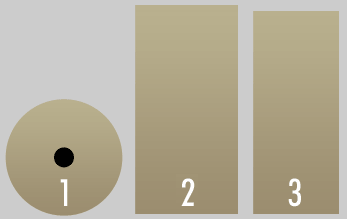 |
| Fig. 1a: Comparative Ice Pads [1] Adelaide Glaciarium Ice Palais, 1904; [2] Melbourne Glaciarium, 1906; and [3] Sydney Glaciarium, 1907. Melbourne's actual ice surface was in-between shapes [2] and [3] in the diagram above and probably the same as [3]. Surface [2] as shown is the area estimated to fit within the quoted 'floor space of 1347m2', less space required for the flanking 'loges' and service areas. However, the quoted area of 1347m2 was more likely the ice surface area, like Sydney [3], which was considered the International minimum at the time. Unlike Adelaide, this was a purpose-built rink that appears much larger than 1347m2 in a 1909 painting (image left) and photos from the 1950s (below). Considered 3rd-largest in the world at the time, its dimensions may also have increased when rebuilt on the same site in 1917. |
The priorities of the first rink design were neither International skating competition or ice hockey. It was not that much more costly to replace the burnt-out roof with a clear-span like the original. The Cyclorama's circular shape was probably attractive to the Syndicate initially. In fact, it was a lot like the first experimental rinks in England — indoor versions of the ice ponds of Scotland on which Poole had probably learnt to skate and play bandy, shinty and curling. Yet, even the first skatable rinks in England 25 years earlier had ice pads measuring 50m x 20m, like the Southport Glaciarium that opened near Liverpool in 1879. Reid had probably never seen them and none of that appears to have mattered to him to start. Adelaide provided Reid with the opportunity to experiment and test his ice floor mechanics at a skatable scale. Poole got to skate for the first time in six years on the first and only figure and speed skating circuit in the country. With music. It is doubtful he was able to skate between the ages of 22 and 28; fairly remarkable for a man who competed in World Figure Skating Championships just 6 years later.
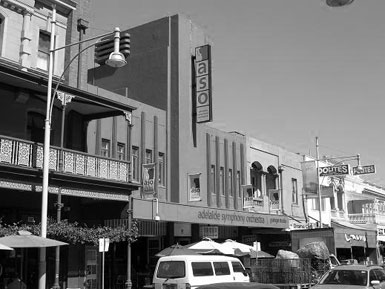 |
| Fig. 1b: Former Adelaide Glaciarium Ice Palais at 91 Hindley Street, later The Olympia Theatre. Now occupied by the Adelaide Symphony Orchestra. |
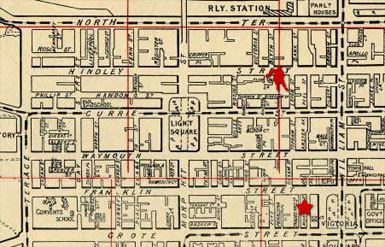 |
| Fig. 1c: Adelaide CBD, north west portion, 1929. The Glaciarium site at 91 Hindley St is marked by the red skater. The red star marks the location of the Metropolitan Ice Works at Central Market, from where the rink's refrigerant was piped. Base map: portion of 'The Register' Street Guide, Adelaide And Suburbs, 1929. |
Reid returned home with the rink's refrigeration equipment [21] and so the heart of the original lived on in the Melbourne Glaciarium. Had the Melbourne building survived, even in part, its 'ice floor' equipment would be its primary architectural and historical significance. Sir George Turner (1851-1916) was Victorian Premier at the time Reid was planning the Mebourne rink. Turner served on St Kilda City Council (1885-1900) and was mayor in 1887-88. Reid had grown up in St Kilda and his parents still lived there. Robour tea merchant James Service (1823-1899) had earlier been Premier and Mayor of South Melbourne, the authority holding jurisdiction over the Melbourne rink site. His grandson, James Service Thonemann, played there in the first officially-recognised ice hockey match in Australia.
Reid opened a full-blown rink capable of competitive ice hockey in Melbourne on June 9th or 11th, 1906. Gone was the pond-style shape of the Adelaide experiment; Melbourne was considered the 3rd-largest rink in the world. It was strategically located for prospective patrons across Princes Bridge from Flinders Street Station, which had started in 1900 and was finished in 1910 (Fig. 2 below). A 1906 picture postcard (pictured left) shows the rink located next to 'T. Craine's Motor Car and Carriage Works, City Road, first street to right over Princess Bridge next Glaciarium'. The precinct was under the control of the South Melbourne (Emerald Hill) municipal association, but it was as close to the heart of Melbourne as possible, a short walk from suburban trains and trams. Surrounding land had traditionally been used for circuses and entertainment and old photos even show a roller skating rink. Many of the city's sporting institutions were established around this time and earlier, among them the Melbourne Cup; the City Baths opening in 1903; and the first Australian Open tennis championship in 1905. The Victorian Football League, forerunner of the AFL, had formed in 1897 when Melbourne Grammar and Scotch College played the first match on record.
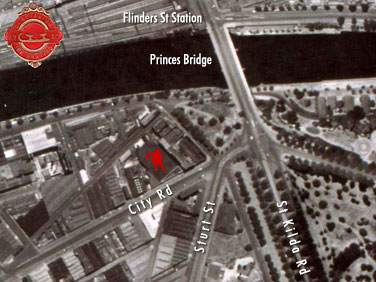 |
| Fig. 2: Aerial Photo, Princes Bridge environs, Melbourne, 1950, before the Concert Hall and Arts Centre; today's Southgate. The Glaciarium is marked by the red skater. The rink had access to both City Road and the street behind; the latter now gone to make way for the South Gate development. |
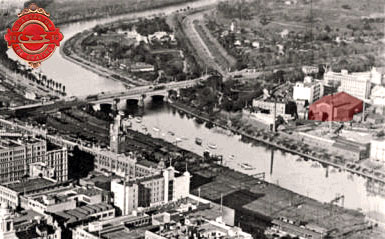 |
| Fig. 3: View from Melbourne CBD toward The Glaciarium (marked red) in 1950, the same year as the map above. The tall building next to it was Nicholas Pty Ltd, the Aspro factory. The rink was directly beneath the central trussed roof which were supported on the columns visible in the interior image (left). The 'loges' spaces each side were also large and used for patron seating and entertainment. The size of the building suggests the ice surface was the same as later built in Sydney (Ice Pad 3 in Fig. 1 above) and the building was larger overall. |
|
'INTERNATIONAL HOCKEY MATCH AT THE GLACIARIUM — AMERICA v. AUSTRALIA
America — U.S.S Baltimore Team — F. G. Randell (captain), R. Stirling, T. H. Miller, J. Benditti, D. F. Kelly, J. T. Connolly Australia — H. J. Blatchley (captain), Dunbar Poole, C. Kelly, J. S. Thonemann, G. Langridge, Salmon The first hockey match — Australia v. America — played on ice in this city, which took place last Tuesday night at the Glaciarium may be marked a complete success, and as the teams had been practising some time, was a good exhibition of the game, and most picturesque. The Australians wore full white suits, the Baltimore boys white shirts and grey trousers. Technically, the Australians were not up to the Americans, but put up a very good game, the result of which was a draw, each team scoring a goal. The sight of the players swiftly gliding and dodging about the ice was very pretty and kaleidoscopic in its changes. Fireman T. H. Miller, of Baltimore, played a magnificent game — in fact, he was the centre of the picture during the whole period of the game — just over thirty minutes.' [36] |
Reid remained at the Melbourne rink as manager, whilst Poole left soon after to manage the rink for the Sydney syndicate, South Pole Ice Rink Limited. Its provisional directors were The Hon. Sir John See (1845-1907, pictured left); W E Shaw, Managing Director Australian Tobacco; and A H Minter. [22] See was the NSW Premier at the time. He had risen from poverty to commercial eminence and the premiership. Although his experience of public life extended over a quarter of a century, he made no lasting impact on the history of New South Wales. During his years in government, he was primarily interested in public works policy and projects and mustered sufficient cabinet support for the Grafton to Casino Railway Act to be carried in the 1890s. He had also been Minister for Railways and so was a clever choice by the rink syndicate as their figure-head when raising capital. See died on January 31st, 1907 at his Randwick home, 6 months before the Sydney rink opened. [24]
Whilst Reid may not have been directly involved with the Sydney syndicate, the High Court law suit he brought against MacDonald's ice floor patent the year it opened suggests he was. [14] The prospectus reproduced in the Sydney Morning Herald [23] named the architect as J Reid and the engineer as R H Barraclough. Architect J Reid may have been related to Henry but his father, John, was not an architect and his younger brother, John, died in infancy. Architect Joseph Reed had died in 1890 although he was related by the 1897 marriage of Henry's niece to Edward Bates. The engineer was mechanical engineer, Sir Samuel Henry Egerton Barraclough (1871-1958), educated at Sydney Boys' High School and the University of Sydney (B.E., 1892). Awarded an 1851 Exhibition travelling scholarship, he attended Sibley College of Engineering, Cornell University. After travelling in North America, he returned to Sydney in 1895 and became lecturer-in-charge of the department of (applied) physics at the Sydney Technical College. He published numerous articles over the years, often connected with steam engines and boilers and, conveniently for the syndicate, he had been granted the right of private practice just two years earlier in 1904. [25]
The site for the Sydney rink in George St at Railway Square, Haymarket, was also occupied by a Cyclorama; probably the first in Sydney that had exhibited 'The Battle of Gettysburg' as Manning recorded. The NSW Heritage Office notes:
"...by 1909 the Cyclorama had been replaced by Sydney Ice Skating Rink & Cold Storage Co. as well as several shops. It seems likely, therefore, that the building was constructed in at least two phases". [40]
The name of the Sydney syndicate's development company was strikingly similar to Reid's Melbourne Ice Skating & Refrigeration Co., except for the word 'Sydney' and a different term for 'Refrigeration'. It is unlikely much of the original Cyclorama was retained in the new rink. It matters more that two of the first three rinks actually replaced two of the first three Cycloramas. Historians say Cycloramas arrived in Australia in 1889, when American entrepreneurs formed jointstock companies in Sydney and Melbourne with local landboomers and businessmen. Some formal association probably existed between Chicago-based Reed and Gross who introduced them, and the rink syndicates that replaced them. They were superseded by the silent film era in which syndicate-member T J West was the major player. However, Coppin's Cremorne Gardens had a Cyclorama of which the Reid's were aware, much earlier in the mid-1860s. The Glasgow company Fishburn Brothers was also associated with the Adelaide Cyclorama, if only through an exhibition rights dispute and, though they may be unrelated, Joseph Fishburn held an ice floor improvement patent in Sydney in 1885 as did Scotsman Charles MacDonald who Reid later sued.
West, who was associated with all three rinks, ran picture shows in the summer months. Old posters show the Melbourne Glaciarium staged international touring shows mid-winter, such as the world-famous Sousa and his Band on June 5th, 1911 (pictured left). History credits West as the first Australian to construct a purpose-built hall for exhibiting motion pictures in 1906; the Melbourne Glaciarium. Before then, films were shown at a range of alternative venues, including converted shops, rented halls and tents. By 1910, West controlled 14 permanent cinemas throughout Australia and his venues were estimated to attract a nightly audience of 20,000. By 1911, his principal competitor, Charles Cozens Spencer (1874-1930), also had a string of cinemas across the country. Spencer began by touring with films through Canada, New Zealand and Australia in 1905. His 1910 documentary 'Marvellous Melbourne: Queen City of the South' shows footage of Melbourne in Reid's time. Capacities of the West and Spencer theatres typically ranged from 2,000 to 4,000 seats. Melbourne Glaciarium was also the first theatre in the world to ever show a true double-feature, two feature films, on May 15th, 1911. They were the Australian movie 'The Lost Chord' from 1911 and an Italian film 'The Fall of Troy' from 1910.
The Sydney Glaciarium was opened on July 25th, 1907 by NSW Premier Joseph Carruthers. [2, 3] It soon became home to the Sydney Glaciarium Ice Hockey Club and the Sydney Ice Skating Club. [46] Photographs of its interior (below and left) show it was essentially the same as its Melbourne forerunner, but stripped of Victorian decoration. It had the same steel-framed, open-trussed roof supported on flanking columns with roof lights in alternating bays, typical of the grand 'sheds' of the era such as Victorian railway buildings. In both, centre-ice was clear of columns; the bandstand was elevated overhead on the end wall with a balcony stair; and the roof peaked about 12m above ice. The rink closed two years earlier than the Melbourne rink in 1955 [1] and the building is now a protected heritage place of high architectural significance to the State and local historical significance due in large part to it's ice skating history. That classification was proposed by heritage architects Graham Brooks & Associates without thorough investigation of the building's full historic significance. This and the Adelaide building are the oldest surviving ice rink buildings in Australia; two of the original three, graced with National, State and local historical significance. The ice floor is probably gone but the original building itself is much more intact than Adelaide. It's last known use was "Technocity". [40] It endures largely unrecognised, awaiting a revival of glory days begun a century ago.
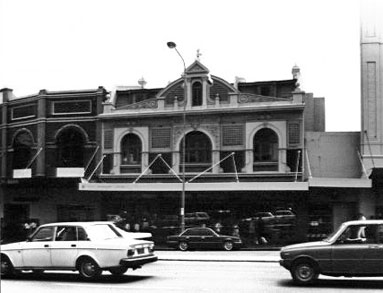 |
| Image above: Sydney Glaciarium Facade (1905-present), recent, operated until 1955. Historical Significance: No. 849-855 George Street records the concentration of commercial development at Railway Square at the beginning of the twentieth century, a reflection of the relationship between this part of the city and Central Railway. The building housed one of Sydney's few ice skating rinks. Has historic significance locally. The building is now protected. [40] |
The Reid family had lived at Brighton where there son Leslie was born in 1894. Brighton Grammar School shares the same associations with the Anglican Church of Australia as Melbourne Grammar. It was founded in 1882 by Dr George Henry Crowther who was headmaster until 1918, after which his son, Lieutenant Colonel Harry Arnold A. Crowther who was in active service in France, subsequently assumed the role of headmaster. There were 160 boys enrolled at Brighton Grammar by 1890 but like MGS, the numbers declined dramatically during the depression. Crowther was deeply involved in many community activities in Brighton and beyond. He was founder of the Secondary Schools Amateur Athletic Association, a member of the councils of Trinity College in the University of Melbourne and Firbank Church of England Girls' Grammar School, and a founder of the Old Wesley Collegians' Society. He was also chairman of the Brighton Gas Co, a trustee of Brighton Cemetery where Henry's father was buried, and for thirty years a churchwarden of St Andrew's Church, Brighton. [37]
Subsequent ice hockey matches are on the record for each year from 1908 until the outbreak of war. Games did not resume until 1921, which was commonly the case throughout most of the International Federation. In the meantime, the Melbourne rink was destroyed by fire in 1917, but reopened on the same site, reportedly in 1923, although the 1922 Interstate hockey series was apparently played in Melbourne [1]. The champion ice skater, Hans Witte, performed there in 1925; a Glaciarium Carnival was held in 1928; and a Glaciarium Ballet Carnival in 1937. Pictures of its interior including skaters are held in the State Library. [52] Ice hockey continued there until the outbreak of the second world war, resuming again in 1946. It was home to the basketball and gymnastics competitions of the 1956 Olympics in Melbourne and finally closed the year after, in 1957. It was the longest operating rink of the original indoor rink era in Australia, perhaps the world. The building was again destroyed by fire on Good Friday, 1964, and this time it did not rise from its ashes. But its spirit lives on 100 years later, and considering what took place there, it is hallowed ground nonetheless.
Both Tange [2] and McKnight [3] have said Reid's son, Leslie, was involved in the construction of the Sydney 'Glaciarium', but that is unlikely because he was only 12 or 13 years old at the time. Leslie is also credited with being a member of the 1st Victorian Ice Hockey team in Sydney in 1907, when he was still very much a junior, aged 13. Tange claims: "Snowy would have been the first Ice Hockey player to have represented both states" but, in fact, that honour would belong to Dunbar Poole, if, as Tange says, Poole played for NSW in the first game there against Victoria in 1907 (see J S Thonemann biography). Leslie Reid was more likely the youngest player in Australian history to make national senior competition!
Leslie and his sister Mireylees moved to Sydney sometime before 1920 where Merrilees was a professional skating instructor. According to Tange, 'she held the Victorian and NSW Figure Skating Championships for many years and Leslie and Merrilees Reid were unbeaten ice dancing champions of Australia'. [2] Ice Skating Australia says of it's own history [12]:
The National Ice Skating Association of Australia was founded in the year 1911 (at Reid's Glaciarium in Victoria). One of its objects of association was: "the furtherance of the art of skating with the view of attaining the highest proficiency amongst the skaters at the Glaciarium in Australia." Despite the wide-ranging objective, skating at the Sydney Glaciarium remained for years the province of the Sydney Ice Skating Club, established a few years later, and this was the figure skating organisation in NSW. The two bodies operated within their own States until 1930, when, following negotiations, their names were changed to National Ice Skating Association of Australia (Victoria) and National Ice Skating Association of Australia (NSW). On June 12th, 1931 a formal agreement was signed between the two State organisations to set up "The Council of the National Ice skating Association of Australia."
The objects of the new Association were, amongst others: "to advise State Associations on all matters appertaining to standards and judging of figure skating on ice; to hold Australian Championships in figure skating in all its branches; to approve of the results of tests judged by state Judges." The new Association did indeed establish Australian Championships, and these were conducted from 1931 onwards, alternatively in Victoria and NSW. In 1932, the Association became a member of the International Skating Union, the body controlling figure skating throughout the world. It was, in fact, one of the earliest members apart from the acknowledged European skating nations. No real steps were taken towards the object of approving tests, and each State continued to operate with its rules, differing in detail from the other, and made to suit local opinion and requirements. [12]
According to the official Australian Figure Skating Championships placings, [12] neither Leslie or Merrilees were ever National ice dancing champions. The first were Victorians P. Turner and R. Jackson (1931-2) and Jackson and A. Maxwell were the first champion pair. Leslie and Mireylees were both in their mid-thirties when the Championships began but Leslie died young the following year in 1932, aged 38. Mireylees at least was still a champion figure skater. The first two National Ladies Figure Skating Championships were won by Victoria's W. Thackeray in 1933-4, but Mireylees was National champion for the first and only time in 1935, representing NSW at the age of 39. [12] Lucy Mireylees N Reid died in Sydney in 1956, aged 60, the last of Henry Newman Reid's family. [28]
'Snowy', Leslie Herbert Reid became Vice-President of the Sydney Glaciarium Ice Hockey Club. [2] Although, as some suggest, he may have been involved with the Sydney Glaciarium since it opened its doors in 1907, [2] it was not until 1912 that he turned 18. [10] There is no known record that Leslie represented Victoria in ice hockey, nor that he participated in an official match in Melbourne. He was 5 years younger than Andy and 3 years younger than Hal. He went on to become a trade Insurance Inspector and a qualified Accountant. He saw active war service in England and France as a First Class Air Mechanic with the 2nd Australian Flying Squadron, AIF, between 1916-19; the first Australian air force to enter the Western Front. [32] He returned safely and represented NSW for many years.
In 1921, the racehorse owner-breeder James Charles Bendrodt (1891-1973) [45] had replaced Dunbar Poole as Sydney Glaciarium Club Patron and Poole had replaced Jim Pike as Club President, whilst Pike remained team Captain. The year prior, 'Snowy' was Vice-President [2] under President 'J. Pike', possibly James Edward (Jim) Pike (1892-1969, pictured left) who will always be remembered for his connection with the legendary Phar Lap. [2] The racehorse owner-trainer, Bendroft, was possibly associated with the Sydney Club through Pike, who's first game on record was at the age of 18 in the 1909 interstate series against Victoria. In 1921, Snowy was Captain of North Shore Ice Hockey Club in Sydney where his ability is said to have rivalled that of Jim Kendall. [1] He also is said to have had an imposing record as an administrator and a speed skater. [2] Leslie died on 11 August 1932 at Sydney, aged 38. [28, 32] In 1949, the St George Ice Hockey Club presented the NSW Association with the Les 'Snowy' Reid Memorial Trophy for inter-team Speed Skating. [2]
'Andy' — Andrew Lambert Reid (pictured left) — represented Victoria in the Victoria vs NSW match played at Melbourne in 1909. [1] He was about 18 years old and that is so far the earliest published record of his entry to the sport. He played for Victoria the following year against NSW in Sydney, the first match played by Victorian John Goodall, whose father, Walker Goodall, donated the AIHL Goodall Trophy. Andy matriculated in 1907 with Physics honours from Melbourne Grammar School and did his Senior Public in 1908. He was a volunteer Cadet at Melbourne Grammar and St Peters College, Adelaide, when his family moved there in 1904 to build its Glaciarium. Andy became a refrigeration engineer like his father with whom he probably briefly worked. He saw active war service as a commissioned officer (Lieutenant) in the 51st Infantry Battalion, AIF. He was killed in action on 9 June 1917 at Messines Ridge, fighting for Belgium's freedom. Andy was aged 27 and buried West of Yaer Canal on the northern outskirts of Ypres, Flanders, Belgium. He is listed on the Menin Gate Memorial at the eastern exit of the town of Ypres:
'REID, Lt. Andrew Lambert, 51st Battalion, 9th June 1917, Age 27. Son of Henry Newman Reid and Lucy Reid, of 9 Blackfriars St, Sydney. Native of Melbourne.' [33]
'Hal' — Henry Newman Reid Jr — died in Melbourne in 1942, aged 51. [10] So far, there is no record that Hal played in any of the officially recognised ice hockey games in Melbourne before the First World War. Unlike his two brothers, Hal did not enlist for active service and little is known about his life during these years, although he may have been the only member of the family to remain in Melbourne. Hal may have played for the Melburnians Ice Hockey Club since its inception in 1908, along with other athletes from Melbourne Grammar. The Club became Melbourne Hockey IHC in 1910. In 1911, either Hal or his father won the men's figure skating event in the inaugural Sydney "Nationals" according to one source. [12] The winner was more likely Hal, Henry Jr, who was aged 20, and less likely Henry Sr who was twice that age or more. Hal may also have taken over the Melbourne Glaciarium from his father, possibly before the War. Their names would appear identical on any surviving records.
Some believe that Reid Sr remained manager of the Melbourne Glaciarium for some time. [2] He had established the first suitable surface for ice hockey in Australia by 1906. By the outbreak of the First World War, he had inaugurated the first phase of the sport's development through his sons and links with Melbourne's earliest Anglican schools, from which the first ice hockey clubs in Australia were formed. The clubs included the first Australian team Melbourne Glaciarium (1907), and subsequently the Melburnians Ice Hockey Club in 1908, and possibly Brighton Ice Hockey Club the same year; two of the official original four. At least two of Reid's sons attended Melbourne Grammar and possibly also Brighton Grammar, as well as their Volunteer Cadets. Henry's father, John, had helped found the Melbourne Shakespeare Society in 1884. Edward Ellis Morris (1843-1902) was its foundation president between 1884-88 and had been headmaster of Melbourne Grammar School 1875-82. Henry Jr was due to matriculate about 1909, and he had probably also attended Melbourne Grammar. Reid Sr himself was quite possibly an Old Grammarian. Three things had emerged as critical to the viability of the sport in Australia: an International size rink; established links to prospective players; and the introduction of Canadian rules and equipment. Henry Newman Reid had presided over all three.
Reid's father, Rev John Reid, died in January, 1911, at his home in Wright Street, Middle Park, at the age of 79. During the war years, Reid and wife Lucy divided their time between Melbourne and Sydney. Henry still lived at 'Locksley' in Malvern but also at 'North Cliff House', Dind St, Milsons Point, around 1916. [35] Lucy lived at the 'Oriental', Cremorne Point, Sydney from May 1917. The couple's sympathy acknowledgement to family and friends in June 1917, after the loss of son Andrew, was addressed Cremorne Point. [67] By July 1917, Reid worked from George St West, Sydney for the Kent Brewery (1835, pictured left) of Tooth & Co Ltd. Breweries had become the largest users of commercial refrigeration units in the 1870s. Tooth & Co. became a public company in 1888 with a capital of £900,000; in 1929 the firm took over Edmund Resch's Waverley Brewery. The Kent Brewery was the producer of the famous 'Tooth's K.B.' beer, and still exists on its original site on the Parramatta Road.
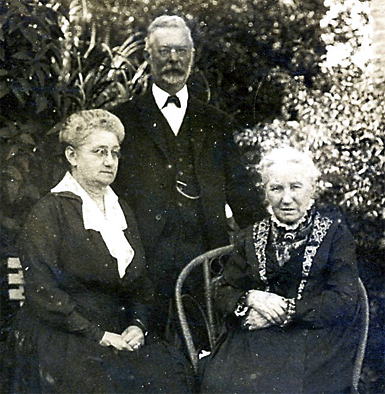 |
| Image above: Henry Newman Reid, wife Lucy (left) and mother Mary Ann Reid (née Mirrilees) before 1918. Image courtesy of Joan Painter, Merrilees Family Association, New Zealand. Enhanced and reproduced with kind permission of the owner. |
On 9 April 1918, Reid — nominated next of kin by his two sons in active war service in England, France and Begium — notified the AIF Base Records office of a change of address from 'Locksley', Haverbrack Ave, Malvern, to Collins Place, Melbourne. [32, 33] His mother, Mary Ann, died that year. From January 1920, Lucy lived at the 'The Rialto', Cremorne Point. In 1922, Reid lived at 'Steveley" Wentworth Rd, Vaucluse, and by January 1923, both he and Lucy resided at 9 Blackfriars St, Sydney. [32, 33] By 1933, during the Great Depression, Reid was in private practice trading as H Newman Reid, Refrigerating and Consulting Engineers at 1-3 Queen St, Glebe, Sydney. He was in his early seventies with a son and daughter still living but two sons deceased. A copy of his professional letterhead and signature from that time appears below. [32, 33]
 |
| Image above: H. Newman Reid (Henry Sr) letterhead and signature, 1-3 Queen St, Glebe, Sydney, 1933. Useful for correctly identifying old documents signed by either Henry Jr or Henry Sr. [33] Click for larger image. |
Henry Newman Reid Sr died in 1947 at the Sydney suburb of Marrickville, aged 85. [28] He was survived by his only daughter, Merilees, outliving all three sons. His wife Lucy may have been interred at Rookwood Independent Cemetery, Sydney, on 30 May 1951. [30] There are no marriage records for the four Reid children in either Victoria or NSW. There are probably no direct descendants of the Henry Newman Reid family line.
Sid Tange asserts in his 1993 hockey history:
"While Mr Newman Reid is credited with building Australia's first two ice rinks, Mr Dunbar Poole, because of his skating ability both as a figure skater and ice hockey player (ability gained in Great Britain, as gleaned from old programmes) would have introduced Figure Skating, Ice Hockey and Speed Skating to Australia." [1]
Reid, not Poole, is rightly credited as the founder of ice hockey in Australia. It would be interesting to see the 'old programmes' referred to because there is no evidence of Dunbar Poole's 'ice hockey' credentials. The early games at the Adelaide rink were described as ball games like bandy or shinty even though hockey had developed its modern form in Canada around 1860. Few Canadians would regard a ball hit with field hockey sticks around a half-sized, doughnut-shaped rink as ice hockey; not even 100 years ago. Apart from the historic 1906 Melbourne game, there is no actual record that Poole even played ball games on ice in Australia. It is equally unlikely that Reid Sr played ice hockey competitively because he was in his forties by the time the first rink was built in Australia and he probably had no prior skating experience. Poole's reputation at the time was that of a highly-regarded rink manager in Britain, if not the best, which also happened to be his role in the Glaciarium syndicates in 3 States. [3] Ice hockey had hardly been played in Britain when he left, let alone officially commenced, and the on-ice experience he brought with him was reputedly figure skating and ice shows.
Poole was a 'proficient' skater. By comparison, Reid's son, Hal, had won the men's figure skating event in the inaugural Sydney "Nationals" in 1911. [12] Poole was in Berlin that year, where he finished last in the figure skating World Championships. Astonishingly, he represented Sweden, not Australia, through his connections with the Swedish royals. Reid family eminence in the community and business worlds in Melbourne and beyond rendered the rink projects viable, not the royals of Europe. Reid Sr was the head of the 'Glaciarium' syndicates. He had lived in Melbourne for 39 years prior to the first consortium. It was he who held the local knowledge, experience and nous to raise the necessary venture capital and to administer the large construction contracts. Reid directed the development process and provided the mechanical engineering expertise, and quite possibly the full building engineering design including structure. It was Reid, not Poole, who organised the import of the first Canadian ice hockey equipment and adopted modern Canadian hockey rules for the 1908 Melbourne games or earlier. Poole had left to manage the Sydney rink.
Although a 'central controlling authority' in Australia is said to have existed since 1923 [1] the Australian Ice Hockey Federation (now Ice Hockey Australia) was officially set up in 1952. Australia joined the International Ice Hockey Federation in 1950. Both were established during the lifetimes of the Melbourne and Sydney Glaciariums which remained the only International ice rinks in Australia for over 30 years. The Ice Palais was opened in 1938 in Sydney by its promoter, Canadian-born Jim C. Bendrodt (1891-1973), who had long been associated with the Sydney Glaciarium and brought the Canadian Bears ice hockey team to Australia that year. Bendrodt arrived in Sydney from Canada in about 1910 and later wrote short stories including a booklet describing his Sydney 'Ice Skating Palais.' In March 1939, Harry Kleiner opened St Moritz in St Kilda near Melbourne. It accommodated more than 2,000 people with over 1,850 square metres of ice and was enormously popular during the war years, operating until 1981 when poor trading finally forced its closure. In the mid-eighties, a fire rendered it derelict and the site remained vacant until its eventual re-development as a hotel named St Moritz in 1991 (Novotel St Kilda since 1999). [54]
Amongst the other notable skaters of Reid's Glaciariums were:
• Kenneth George "Ken" Kennedy (1913–1985), the first Australian Winter Olympian, was born in Sydney and was a speed skater and ice hockey player with one of the highest profiles ever in Australian winter sports. He started his active ice hockey career with Eastern Suburbs IHC in NSW in 1928, the Club Jim Kendall captained, and debuted in the 1931 Goodall Cup as a 17 year old. Kennedy was the Australian quarter mile and mile champion speed skater from 1931 through to 1934. He was Senior Dance National Champion with S. R. Croll in 1933, 1935 and 1936 representing NSW. [12] He travelled overseas for more specialised training and competition leaving Australia in December 1934 for England, where he won the British indoor titles for the half-mile and mile in 1935 and 1936. He was then selected for the 1936 Olympic Games in Garmisch-Partenkirchen where he competed in several events. In 1935-6, he played for England's Birmingham Maple Leaf ice hockey team for three seasons, 1934-37, during which time it won the English League Championship.
After the war, Kennedy returned to Australia where he played ice hockey for another six years. He was the first president of the Australian Ice Hockey Federation between 1952 to 1964 and it's delegate to the Australian Olympic Federation, where he argued that overseas trips would be needed for Australia to reach world standard. Kennedy was succeeded by John Purcell 1976-80, defenseman and Captain of Australia in the 1962 ice hockey World Championships; Phil Ginsberg OAM from 1981 until his death in 1998; and presently Don Rurak. Kennedy was admitted to the Sport Australia Hall of Fame in December 1986 as an athlete member for speed skating. To date, no ice hockey athletes have been inducted.
• Colin Hickey became a "rink rat" when his father first took him to the Melbourne Glaciarium. At the Games at Bislett, Oslo in 1952 he was no more impressive than Kennedy had been but, from 1955, he travelled regularly to Europe for winter training and improved his results dramatically. Hickey was Australia's first great skater. He qualified for the 10,000m in world championships twice, 1956 and 1959, both in Oslo. Both times his result was 11th overall. In the Olympics, he finished 7th place twice from Misurina, 1956. At the world championship in 1960, he became the first Australian medallist, 3rd-placed in the 500m. His 7th place in the 1956 Winter Olympics was Australia's best result until 1976.
• Ben Acton (1927- ), Forward, of Footscray, Victoria, Captain of Australia in the 1960 Olympics, Squaw Valley, US and the 1st Australian Team in the Ice Hockey World Championships. In 1950, Ben Acton was selected to play Field Hockey for Australia. A great all-rounder, Ben also trained with the Footscray Football Club as a young man. [50]
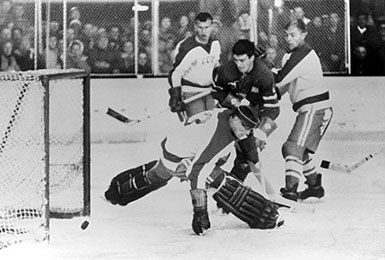 |
| Squaw Valley February 1960. Men's ice hockey, USA - Soviet Union match (3-2). Roger CHRISTIAN scores for the USA. This team authored the first "Miracle on Ice" chapter in U.S. Olympic ice hockey history, winning the gold medal. The U.S. team went unbeaten in seven games (IOC/Olympic Museum collections). |
• Ken Wellman (1930- ), Defenseman, Captain of Australia in the 1962 World Championships. Played ice hockey for Monarchs IHC, Melbourne. Played for Australia in the 1960 Olympics and the 1964 Olympic Qualification Team. Played in the 1st Australian Team in the Ice Hockey World Championships.
• Russell Jones (1926- ), Forward, Captain of Australia in the 1964 Olympic Qualification Team. Played ice hockey for Pirates IHC, Melbourne. Played for Australia in the 1960 Olympics, Squaw Valley, US and the 1st and 2nd Australian Teams in the Ice Hockey World Championships.
• Charles 'Charlie' Grandy (1939- ), Defenseman,. Captain of Australia in 1974 and 1979 Olympic Qualification Tournaments. Captain of Victoria on numerous occasions between 1972-81. Born in Brooklin, Ontario, Canada. Arrived in Australia in 1963 and played ice hockey for St George IHC, NSW, 1963-64. Moved to Melbourne in 1964 where he played for Blackhawks, Melbourne, 1964-66 & 1971-81. Returned to Canada in 1966 before returning to Australia in 1971. Played for Australia in the 1963 Olympic Qualification Tournament and the 1974 & 1979 (Pool C) World Championships. Represented Victoria in the Goodall Cup 1972-81. Father of Glenn Alan Neal Grandy, Left-wing, who played for Austalia in the 1990, 1996 & 1997 (Pool D) and 1992 & 1995 (Pool C) World Championships; won World Championship Pool D silver in 1990 and Pool C bronze in 1992.
• Ron Amess (1927- ), Forward, played ice hockey for Australia in the 1960 Olympics, Squaw Valley, US and the 1st and 2nd Australian Teams in the Ice Hockey World Championships. Amess is still active in the sport and presents trophys annually at Australian ice hockey championships.
• Lindsay Fox (1937- ), Melbourne entrepreneur, Linfox, president of St Kilda Football Club. Although there is no record, Fox said on the George Negus Tonight TV show (12 Aug 2004): "I started ice-skating when I was about 12 or 13 and I was selected in the Australian team for ice hockey. I met my wife at St Moritz Ice Skating about 1955."
Others who played for Australia in the 1960 Olympics and the 1st Australian Team in the Ice Hockey World Championships included:
• Noel Derrick (1926- ), Forward, Blackhawks IHC, Melbourne.
• John Nicholas (1928- ), Defenseman, Blackhawks IHC, Melbourne.
• Noel McLoughlin (1929- ), Netminder, Demons IHC, Melbourne.
• Clive Hitch (1931- ), Forward, Blackhawks IHC, Melbourne.
• Robert Reid (1932- ), Netminder, Blackhawks IHC, Melbourne.
• Victor Ekberg (1932- ), Defenseman, played for Harringay Hornets in the 1950s in the Southern Intermediate League, London, England (1951-55) and Pirates IHC, Melbourne.
• Steve (Zdenek) Tikal (1933- ), Forward, played ice hockey for Hakoah IHC, Melbourne. Born in Czech Republic, twin brother of Czech international defenseman, Frantisek Tikal, who scored 80 goals in over 360 games in the Czechoslovak league and 17 goals in 59 games for his country. He won two medals in two Olympics and was inducted into the IIHF Hall of Fame in 2004. Despite what some say about the twins competing against each other in the Olympics, Steve Tikal was not played by Australia although he was a team member.
Australia's participation in Olympic and International ice hockey produced its first medal in 1987, 80 years after Reid established the first rinks and almost a quarter of a century after Kennedy had first argued that overseas trips were necessary for Australia to reach world standard. Australia won IIHF Pool D gold that year and the record for the highest ever score in a World Championship match against Team New Zealand — 58-0 at Perth on March 15th, 1987. [43] Over the 20 years since, Australia won a further 10 World Championship medals: Pool D silver in 1990 & 1998, Pool C bronze in 1992, Pool D bronze in 1999 & 2000, Division II (Group A) bronze in 2001 and 2004; and silver 2005-07. Although Australia is yet to achieve Division I World Championship standard, it is closer than ever before and as Meltzer [55] noted recently : 'Ice Hockey Australia hopes a day comes when the AIHL is also a choice off-season destination for foreign pros on the rise — much like fall and winter league baseball in the US and Latin America — as well as a breeding ground for an Australian national team solidly entrenched in the IIHF's Division One level.'
The first Australian rinks did not just pop up in response to an unmet demand. They were precise; the results of a well-conceived development strategy, expertly implemented in three States in consecutive years 1904-7. They were not government-assisted, as often happened elsewhere, they were pioneering entrepreneurial enterprises. They were not assembled by amateurs but by educated and otherwise capable men, syndicated to manage all associated risks. In one clean sweep, Reid's syndicates succeeded in establishing International standard rinks in the two largest cities, in two States, in two years, providing all that was necessary for the birth of National competition. That feat would be impressive today, let alone 100 years ago. An assist and two nets from three faceoffs.
The significance of the achievement is easily lost between the cracks of history. Without Reid, Australian hockey would not have commenced until much later, as it did in many other member nations of the Federation. Perhaps not until the 1920s, given the effects of the First World War. Perhaps even later; the New Zealand Ice Hockey Federation was not formed until 1987. Similarly, the Goodall Cup would not be hockey's third-oldest prize still in existence, because it could not have been contested until at least a decade later. The Goodall Cup was first awarded in 1909, the year before the first European Championship was played. Only the NHL's Stanley Cup (1893) and Canada's Allan Cup (1908) are older. Reid's syndicates positioned hockey in Australia at the forefront of it's emergence internationally, enabling it to form its first controlling body the same year the IIHF itself was established. They gave it a head start, if you like, something that uniquely defined it and energised it for a century, shaping it for centuries still to come.
The Reid family and, most particularly, Henry Newman Reid Sr — the founder of Ice Hockey in Australia — were well and truly Melburnians, long before they launched Australia's first ice rinks and ice hockey. That is not a statement about primacy nor does it diminish Reid's partner, Poole, nor, for that matter, Tange or NSW hockey. It's Reid's biographical record, with due respect to his engineering and pioneering enterprise in laying the foundations of National ice sports and particularly hockey. His work started years earlier, and endured for much longer, but it culminated in his hometown of Melbourne, in 1906-8.
An inch of rain equals ten inches of snow and what Henry Newman Reid achieved at the turn of last century, was remote as could be in the hockey world, at the opposite end of the globe, in the driest continent on earth.
Remembrance Day, 2007. For Jack and hockey's once and future champions.
© 2007 Ross Carpenter B Arch (RMIT) M Des (Urban Design) ARAIA.
All Rights Reserved. Original Research Nov 07. Reproduction prohibited without prior written permission of the author except for the inclusion of brief quotations in a review.
Citations and Notes:
[1] "The History of the Goodall Cup", author not stated, Ice Hockey Australia, IHA website.
[2] "Ice Hockey: The NSW Ice Hockey, Association Inc. Australia - Facts and Events 1907-1999" by Sid Tange (1999). 175pp. unpublished manuscript; Extracts published in 2007 on the IHNSW website for the 2008 Centenary.
Sydney Tange (1917- ?)
First involved with ice hockey at St George Ice Hockey Club in 1937 as player and later Secretary / Treasurer. Playing career finished in 1947 when he became Secretary of the NSW Association, a position he held almost 12 years. He was acting President 1964/65. Awarded Life Membership of the NSW Association in 1960, and Life Membership of the Australian Ice Hockey Federation in 1962. President of the Glebe Lions Ice Hockey Club, and the Easts Monarchs Club; Life Member of the latter. Co-organiser of first interstate Junior Ice Hockey match in 1951 with the late Mr Alwyn Stuart (manager of St Moritz Ice Skating Rink, Melbourne, and President of Pirates IHC). Assistant Manager of Australian Team competing in the 1962 World Championships in Colorado, USA. President of the Australian Federation, from 1970-73. Presented with the H.C. and S.M. Hudson "Sportsman of the Year" Trophy in 1967. The National 17 years and under Tournament was named the Tange Trophy after him in 1969.
[2a] Glaciarium Ice Hockey Club Minutes, Minutes of Special Meeting held July, 1920. Following office bearers were elected.
Patron: Mr Dunbar Poole,
President: Mr. Jim Pike.
Captain: Mr. J. Pike.
Vice-President: Mr. L. 'Snowy' Reid.
General Committee: Messrs Gibson, Kerr, Maling.
Selection Committee: Messre Pike, Reid, Josephs.
Hon. Secretary/Treasurer: Mr. Norm Josephs.
Annual Subscription: 5/- (shillings) Formerly 2/6 (Two shillings and sixpence).
Members: N Josephs, T Gibson, J Gardener, R Benjamin, E Benjamin, E Hallet, J Cohen, J O Gates, F Josephs, L Reid, S Cohen, W Scott, Maling, Collette, F White, C Kerr, Capenter, Welby, Goodwin, Mr Thew, C Harries, W Bujioff, H Ives, H Butler, Mr Howe, Mr Palsew, Mr Glasburn, Mr Jantsen, Mr Gallagher, Mr Brown, Mr Roberson, N Wright, Mr Pakel, Mr Stenz.
Annual General Meeting: Saturday 28th May 1921.
Patron: Mr Bujioff., Prop: Mr Reid., Sec: Mr Thew.
President: Mr Dunbar Poole, Prop: Mr Kerr., Sec: Mr Harris.
Captain: Mr Pike., Prop: Mr Reid, Sec: Mr Josephs.
Vice Captain: Mr Reid., Prop: Mr N Josephs., Sec: Mr C Harris
Secretary/Treasurer: Mr N. Josephs., Sec: Mr J Pike.
Committee: Mr N Josephs, Prop: Mr Ives, Sec: Mr J Pike.
Mr T Gibson., Prop: Mr Ives., Sec: Mr Gardener.
Mr Kerr, Prop: Mr Collette., Sec: Mr Butler.
Selection Committee: Messrs Pike, Reid, Josephs.
Gear Steward: Mr N Joesphs, Props: Mr Ives., Sec: Mr Gibson.
Annual Subscription: 5/- (shillings).
Members: F White, E Benjamin, J Gardener, J Pike, C Kerr, N Benjamin, Carpenter, F Josephs, N Josephs, T Gibson, M Loart.
[2b] The NSW Ice Hockey Association. Late Sydney Ice Hockey Club. First page: Minutes of Committee Meeting 22nd June, 1921. Mr N Josephs, Hon Secretary/Treasurer. Proposed by Mr L. 'Snowy' Reid, seconded by Mr. N Josephs, that the name of the club be the Sydney Ice Hockey Club. Carried. The four clubs formed were:
1. South Sydney Ice Hockey Club
Team Composed of: T Gibson (Capt), H Butler, C Fowler, E Hewitt, Dr Murphy, W Power.
2. Eastern Suburbs Ice Hockey Club
Team composed of: E.J. Kendall (Capt), F Josephs, W Panter, F Whyte, H Tanner, S Schute, J. Lovelace.
3. Western Suburbs Ice Hockey Club
Team composed of: J Pike (Capt), C Kerr, Dr Hamilton, W Store, T Wells, J Kerr, W Webb, J. Carpenter, J Lowick.
4. North Shore Ice Hockey Club
Team composed of: L Reid (Capt), C gates, N Josephs, H Ives, W Watkins, R Boyden, H Hinder, D Cathro, S Green, L Catro.
[3] 'History of Skating in Australia: Ice skating rinks in Australia and some of the personalities associated with them'. Donald McKnight, October 2007 (Friends of ISQ website)
[4] Mirrilees Family Association, New Zealand, Tree 09, 2007. H N Reid's mother: Mary Ann Mireylees b. 15 Mar 1831, Edinburgh, d. 1918, Aus m. 3 May 1854, Dundee John Lambert Reid. H N Reid's brothers: John Reid b. 1864 d. 1865 Aus; William Eliot Reid b. 1858 d. 1939, Aus; Andrew Lambert Reid b. 1868, Aus d. 1889, Aus; Edward Crichton b. 1872. Sisters: Mary Anne Lambert b. 1859 d. 1946; Louisa b. 1861; Agnes b. 1863, England, d. 1956, NZ, m. 1899 Kenneth Phin; Alison b. 1868 d. 1955, Aus; Edith b. 1869 d. 1947, Aus; Kezia McCallum b. 1873 d. 1958, m. 1895 Thos Wm Cooper, ch. Robert, John and William.
[5] British National Archives UK Outbound Passenger Lists, 1890-1939; Dunbar Poole, age 22, departed 1899, Glasgow to Melbourne and departed London, 1925 to Sydney aged 49. Ancestors Onboard.
[6] Skating A Brief History of Ice and The National Ice Skating Association of Great Britain, Denis L. Bird, NISA Archivist and Historian, NISA Online
[7] Homes of British Ice Hockey, Martin C. Harris
[8] 'The Evolution of Ice Rinks', Ted Martin, published in ASHRAE Journal, November 2004, American Society of Heating, Refrigerating and Air-Conditioning Engineers, Inc.
[9] 'History of ice skating rinks.' Ice and Refrigeration. Carpenter, M.R. 1941. July.
[10] Australian Births Deaths and Marriages Index, Public Records Office Victoria; marriage Reg No. 5795; children's births: Andrew Lambert Newman Reg No. 34146; Henry Newman (Jr), Reg No. 30382; Leslie Herbert, Reg No. 1201; Lucy Merrilees, Reg No. 22482. Children's deaths: Henry Newman (Jr), Reg No. 2960. Note birth and death registrations of Henry Newman Rd Jr. cite parents as Henry Newman Reid and Lucy Marsden. Mary Ann Reid (nee Merrilees) Death Reg No: 5211/1918, father Robert Mireylees, mother Catherine Louisa Wright. Children of John Lambert Reid and Mary Ann Mirilees born in Victoria: John Reid, born: 1864 Reg No: 24343; Andrew Lambert Reid born: 1866 Reg No: 4446, died: 1889 Reg. 13396; Alison Reid, born: 1868 Reg No: 10018; Edith Reid, born: 1869 Reg No: 21179; Edward Crichton Reid born 1872, Reg No: 7736; Kezia McCallum Reid born: 1873, Reg No: 5950.
[11] Australian Births Deaths and Marriages Index, Public Records Office Victoria; Lucy Marsden birth registered 1865, Melbourne, to parents Joseph Marsden and Elizabeth Sarah Kitchen. This is the only possible registration record in the State at the time, but Lucy may not have been born in Victoria.
[12] Ice Skating Australia (ISA) website. Site includes downloadable PDF files for National and International Skating placings 1911-2007. Online. This is only recorded in source [46] and it is not known whether the winner of the 1911 National was Henry Newman Reid Senior or Junior. Henry Reid Jr. was about 20 years of age and Henry Sr. was over age 39. Mirilees Reid was Ladies National Figure Skating Champion in 1935 (Placings National Champions 1931-2004). History and foundations of ISA: Online
[13] History of Skating in Australia, Ice Skating Rinks in Australia and some of the personalities associated with them, Donald McKnight, October 2007 (Friends of ISQ website)
[14] The Melbourne Ice Skating and Refrigerating Company Limited [includes Appeal Book], 1907, REID Henry Newman versus MacDONALD Charles Arthur; Full Court case records (Victoria) and from 1973, Court and Cause case records, annual single number series, National Archives of Australia, Canberra, Series No. A10074/1, Control Symbol 1907/21, Barcode: 3148899
[15] An improved ice skating rink, Correspondence with Charles Arthur MacDonald concerning invention, Sydney 18th Aug 1896; National Archives of Australia, Canberra, Series No. A4619, A13150 Barcode: 4286223. 6pp NAA Digital Image and 1896 - 1904, Series No. A12572, , Series accession number 2003/00041274, 9041750
[16] A method of producing and maintaining an ice floor for skating and other purposes of amusement, Specifications for registration of patent by Arthur Otto Sachse and Charles Edwin Jones, 1888, National Archives of Australia, Canberra, Series No. A13150, Series accession number 2006/00176198 Barcode: 9041750; Registered as Patent 2850, Series No. A13128, Series accession number 2006/00176198
[17] Improvements in and relating to ice rinks, Specifications for registration of patent by Joseph Fishburn [assignee of Felix Unsol], 1895 - Patent not registered, National Archives of Australia, Canberra, Series No. A13127, related correspondence: Series No A4618.
[18] 'Sachse, Arthur Otto (1860-1920)', Geoff Browne, Australian Dictionary of Biography, Volume 11, Melbourne University Press, 1988, p. 505. Online
[19] 'Jones, Charles Edwin (1828 - 1903)', Geoffrey Bartlett, Australian Dictionary of Biography, Volume 4, Melbourne University Press, 1972, pp 488-489. Online
[20] 'Coppin, George Selth (1819-1906)', Sally O'Neill, Australian Dictionary of Biography, Volume 3, Melbourne University Press, 1969, pp 459-462. Online
[21] 'A Short History of Skating in Australia', Ice Skating Australia Online
[22] 'Prospectus: South Pole Ice Rink Limited', Sydney Morning Herald, March 28th, 1906. Transcript: Prospectus: South Pole Ice Rink Limited, 20,000 Capital. Shares P1.00.00 each half of which have been taken. Provisional Directors: The Hon. Sir John See, W E Shaw, Managing Director Australian Tobacco, A H Minter. Engineer - R H Barraclough. Architect - J Reid. Accoutant - Kent Brieley and Sully. Heating in colder weather. Estimated attendance per day, Morning at 2/-. Afternoon 75 at 2/-, Evening 200 at 2/-. Spectators reserved seating total £10.10.00. Total £43.00.00 per day. Estimated £125.00.00 profit per week. Net profit over 40 weeks £5000.00.00. Construction of Melbourne Ice Rink underway. Note: 'R H Barraclough' was probably wrongly transcribed from S H Barraclough . See source [25].
[23] 'Fashionable Ice Skating Rink' Preliminary notice', Sydney Morning Herald, June 6th, 1907; Quote: Opening 25 July 1907. Manager Mr Dunbar Poole, Admission - 2/- skates 6 pence; Sessions 10.00 am - 12.00 pm, 3.00 pm - 5.00 pm and 8.00 pm - 10.00 pm; Opening ceremony by the Honourable Premier J Carruthers, 3.30 pm Saturday 25 July 1907.
[24] 'See, Sir John (1845 - 1907)', Keith Henry, Australian Dictionary of Biography, Volume 11, Melbourne University Press, 1988, pp 560-562.
[25] 'Barraclough, Sir Samuel Henry Egerton (1871 - 1958)', J. M. Antill, Australian Dictionary of Biography, Volume 7, Melbourne University Press, 1979, pp 184-185.
[26] Melbourne photo-map [map]: Melbourne B4B (part 2) Victoria, 1945. Dept. of Lands & Survey, Call No: MAPS MX 820.953 br (var) 1945-
[27] Lucy Marsden was possibly the daughter of Joseph Marsden and Elizabeth Sarah Kitchen born in Victoria, Australia in 1865. See Birth Reg. No: 15608, Australian Births Deaths and Marriages Index, Public Records Office Victoria
[28] 'New South Wales Registry of Births, Deaths and Marriages Historical Index', Henry Newman Reid Death Reg No: 20808/1947, Marrickville district, parents John Reid and Mary Ann. (Marrickville was formed by amalgamation of Marrickville, Petersham and St Peters municipal councils in 1948). A John Reid, with parents named same as Henry, died at Grafton in 1936, 11 yrs prior to Henry; Reg No: 11872/1936. Possibly brother (born Melbourne after parents arrived); possibly 'J. Reid', architect of Sydney Glaciarium.
Lucy Mireylees N Reid, Death Reg No: 601/1956, Sydney, parents Henry Newman Reid and Lucy. Leslie Newman Reid Death Reg: 10472/1932, Sydney, parents Henry Newman Reid and Lucy.
[29] 'Unassisted Immigration to Victoria: Index of Inward Passenger Lists for British, Foreign and New Zealand Ports 1852-1923', Public Record Office Victoria, Fiche 232 pp. 5 and 7, 'Empress of the Seas', arr. Port Phillip Jun 1864 from British Port, passengers: Parents John aged 31 and Mary A aged 30, Children William, aged 6; Mary, aged 4, Louisa, aged 3; Henry, aged 2; and baby Agnes.
The Public Records Office database records the 1961 voyage as 'Empress of the Sea' and the 1864 and onward voyages were 'Empress of the Seas' (plural). The latter ship was an extreme clipper built by Donald Mackay and destroyed in 1861 as noted below. It could not have made the 1864 voyage yet that is how it is recorded in the PRO database. 'Empress of the Sea' was a smaller 1,243 tons wooden ship fastened with iron bolts and also owned by the famous Black Ball line of Liverpool. She was built in 1863 at Hilyard in New Brunswick and measured 57.9m long with an 11.9m beam (189.8' long, 39.2' beam, holds 23.7' deep). 'Empress' sailed the Liverpool to Melbourne line and her maiden voyage on that run was probably in 1864, with the Reid's onboard, under Capt Davis. When the owners of the shipping line, James Baines & Co, were in financial troubles in the 1860s, Capt. Thomas Williams bought some of the old wooden ships from them, including 'Empress of the Sea' in 1866, which he sold in 1871. Capt. Williams of Parciau, Criccieth and Liverpool, was formerly Master then Marine Superintendant with the Black Ball Line.
'Empress of the Seas' James Baines & Co purchased this large extreme clipper built by Donald Mackay in September 1860 from Wilson & Sons of Baltimore. She soon joined the Black Ball fleet on the Liverpool-Melbourne run. On her second voyage, she made a phenomenally fast passage to Melbourne in 66 1/2 days. One source says she was anchored off Port Phillip at the quarantine station at Port Nepean waiting for the morning tide of December 19, 1861 to begin the homeward passage, when a fire in the fore hold broke out that destroyed her. Mackay also built 'Sovereign of the Sea's and 'Champion of the Seas'.
[30] 'Rookwood Independent Cemetery, NSW', A Lucy Jane Reid was interred in the Methodist Section 1W Grave No: 0000229, on 30 May 1951. Online
[31] 'The Manning Index of South Australian History', State Library of South Australia, Adelaide Cyclorama, Hindley St (1890-1899); Newspaper citations: The opening of a cyclorama is reported in the Register, 29 November 1890, page 6e, 18 May 1892, page 4f; also see 1 October 1892, page 5c, 20 March 1893, page 5b, 5 December 1898, page 7d, Express, 18 and 30 September 1890, pages 4c and 3f, 29 November 1890, page 3e, 24 March 1891, page 2c, 5 April 1893, page 4d. Its destruction by fire is reported in the Express, 11 March 1899, page 2c. See also: 'A Colonial Experience', Geoffrey H. Manning. Online
[32] 'First Australian Imperial Force Personnel Dossiers, 1914-1920, Air Force Service Records, Leslie Herbert Reid: Service No. 714', National Archives of Australia, Canberra, Series No. B2455 Barcode: 8028174. 50pp, NAA Digital Image
[33] 'First Australian Imperial Force Personnel Dossiers, 1914-1920, Military Service Records, Andrew Lambert Reid: Service No. 714', National Archives of Australia, Canberra, Series No. B2455 Barcode: 8025997. 58pp, NAA Digital Image
[34] 'Correspondence from H Newman Reid, Refrigeration & Consulting Engineers, Letterhead, Glebe, NSW', digital images contained in source 32.
[35] 'Luna Park – Site C Environmental Assessment Report November 2006', NSW Planning Dept, According to the Archaeological Assessment prepared by ERM and included at Appendix H, the site did contain a dwelling known as Northcliff house. Evidence of this dwelling appears in 1870, with the dwelling later demolished after 1926. The site was later used to accommodate the top of the ‘Jack and Jill’ ride as part of Luna
Park during the 1940s and from 1960 has continued to be used as a car park.
[36] 'Melbourne Punch' newspaper, Thursday, 19 Jul 1906; Published on p. 88 of the weekly, received and date-stamped at the Pubic Library of Victoria on 21 July 1906. IHA wrongly cite the year as 1907 ("History of the Goodall Cup") and Sid Tange as 12 Jul 1906 (IHNSW), the Thursday prior to the publication. IHA and IHNSW histories both contain numerous other errors including the score, initials and spelling of most players' names.
[37] 'Crowther, George Henry (1854-1918)', C. E. Sligo, Australian Dictionary of Biography, Volume 8, Melbourne University Press, 1981, pp 163-164.
[38] 'Merrilees Clan' website, 'Origin of our Surname'. 'Merrilees' was the registered name at birth of Reid's only daughter. Her name is recorded as 'Lucy Mireylees N Reid' on her death certificate. Lucy was her mother's name and the 'N' no doubt stood for 'Newman'. Merrilees/ Mireylees and derivatives is very rare as a first name. Its origin is a Scottish surname generally believed to be derived from the place name of a 12th-century estate and hamlet in West Lothian, near Edinburgh in Scotland. On a 1773 map of West Lothian, the name is printed as 'Myrey Lees' and John Black's 1830 map of Linlithgow shows 'Merrylees' on the south edge of 'Binns'. A row of old stone houses which remain on this site today are called 'Merrylees Cottages.' The name is believed to have arrived in Scotland from Norway. See also 'Notes on our Surname and its Variants' by Ronald Merrilees and the poem 'Meg Merrilies' by John Keats (1795 - 1821).
[39] 'Outward Passengers to Interstate, UK, NZ and Foreign Ports 1852-1876', Public Record Office Victoria.
[40] 'Federation Free Style Commercial Building, 1905, 849-855 George Street, Haymarket, NSW, 2000.' Other Name/s: Glaciarium, Technocity, Statement of Significance, NSW Heritage Office, Heritage Listing - Local Environmental Plan, Sydney LEP 2005, No. 164, Gazette Date 09 Dec 05, p. 131. Online
[41] According to Source [1], the following advertisement appeared in the Adelaide Advertiser on Tuesday October 11, 1904:
'GLACIARIUM GLACIARIUM (ADELAIDE) ICE PALACE SKATING RINK
DECLARED BY EXPERT CONTINENTAL SKATERS TO BE THE FINEST RINK IN THE WORLD THE ONLY ONE IN AUSTRALIA OVER 8,000 SUPERFICIAL FEET OF REAL ICE
GREAT HOCKEY MATCH, WEDNESDAY EVENING NEXT (12TH inst.),
Rink vs Scratch Team, starts 9pm. Seating Accommodation for 3,000 People. Illuminated by Electricity. Refreshments of all kinds. Opening Morning, 10-12; Afternoon, 3-5; Evening, 7:45-10 Admission, 1/S Skates, 6d.;Floorage. 6d. ; Children under 10, Half price, Morning and Afternoon only. H NEWMAN REID, General Manager.'
However, the rink had probably not opened until 1905. The earliest record of an ice hockey match was reported 5 and 12 July 1905 in the Adelaide newspapers Express and Advertiser. See Additional Research Item [2] below.
[42] 'Australian Olympic Committee, Ice Hockey' Online
[43] 'Guinness World Records 2008'
[44] 'Australian War Memorial, 1997-2007, Roll of Honour', Lt. Andrew Lambert Reid, AWM145 Roll of Honour cards, 1914-1918 War, Army, Online
[45] 'Bendrodt, James Charles (1891 - 1973)', Australian Dictionary of Biography, Online
[46] 'Australia Celebrates a Centenary', Susan D. Russell, International Figure Skating Magazine, December 2004, written with reference to files from John Baster (UK), Frank Parsons, Bob Battersby, and Don McKnight (Aus). Note that this brief article contains inaccuracies and much of the information comes from Tange [2], vice versa, or an unknown third source shared in common. Online
[47] British National Archives UK Outbound Passenger Lists, 1890-1939; Dunbar Poole, age 22, departed 1899, Glasgow to Melbourne; departed Liverpool to Sydney 1909 aged 31, 1910 aged 32 and 1912 aged 34; departed London, 1923 to Melbourne aged 45, and 1925 London to Sydney aged 49. Ernest Poole aged 38 departed London, 1911 to Melbourne Ancestors Onboard.
[48] 'Unassisted Immigration to Victoria: Index of Inward Passenger Lists for British, Foreign and New Zealand Ports 1852-1923', Public Record Office Victoria. Dunbar Poole, aged 22, immigrated from a British port in Sep 1899 aboard ship 'Loch Garry', Fiche 650, p. 2; and aged 32 from a British port in May 1910 aboard ship 'Medic', Fiche 802, p. 2; and aged 35 from a British port in Apr 1912 aboard ship 'Afric', Fiche 846, p. 3.
[49] 'A to Z Encyclopaedia of Ice Hockey', Edited by Phil Stamp in association with Stewart Roberts, 1998-2007, Online Australian Squads Online
[50] 'Footscray Hockey Club (1934-present), Timeline. Online
[51] 'Full Olympians', Herman De Wael, Online
[52] 'Activities of the Ski Club of Victoria in the Victorian snowfields and the Glaciarium Carnival of 1928', Magill, Kathleen 1903-1986, photographer, State Library of Victoria, Accession no: H97.190/533-631, Call number: PIC LTAF 740. Kathleen Magill was a member of the Ski Club of Victoria as well as a founding member of the Australian Women’s Ski Club. Gift of Mrs. Patricia Lemon, 1997. Album documents activities of the Ski Club of Victoria showing ice skating and skiing at Mount Buffalo in 1928, a party at en-route to Mount Hotham for the Ski Club of Victoria championships at Mount Hotham, the winning team in fancy dress in a decorated car from the Glaciarium Carnival of 1928, including interior views of the Glaciarium with skaters, and excursions to Mount Donna Buang and Lake Mountain in 1929.
[53] 'T. CRAINE'S MOTOR CAR and CARRIAGE WORKS. City Road, First Street to right over Princes Bridge next GLACIARIUM', picture, Date(s) of creation: [ca. 1906], postcard : printed, col. ; 8.8 x 13.8 cm. approx. Reproduction rights owned by the State Library of Victoria, Accession Number: H42667/56, Image Number: a04709
[54] 'St Moritz - The Skating Lady', 2005, St Kilda Historical Society, Online
[55] 'Across the Pond', Bill Meltzer, NHL.com Correspondent, Sept. 14, 2006, Online
[56] 'Merrilees Clan Website' Online, Henry's mother, Mary Ann Mirilees, belongs to the Merrilees Clan MFA Tree #9. All of the Merrilees Family Tree branches in Australia and New Zealand are proven by DNA testing to be related through a common ancestor, currently identified by MFA research as James Mirrileyis (born abt 1610) who married Elspeth Blair in Ormiston in 1641. James was a blacksmith in Pencaitland, East Lothian. The first member of this family to go to New Zealand was Henry's sister 36-yr-old Agnes Reid in 1899. She was the fifth child born to Mary Ann Mireylees and Dr John Lambert Reid in Scotland before the family emigrated to Australia in 1864, where four other siblings were born. Agnes immigrated from Australia to Alexandra in Otago and married Kenneth McLeay Phin. Henry Newman Reid links to the Merrilees common ancestor through Robert Mireylees (abt 1780) and Euphemia Dunbar who married in Edinburgh, 15 March 1799.
[57] 'Reid, Robert (1842 - 1904)', Margaret Steven, Australian Dictionary of Biography, Volume 11, Melbourne University Press, 1988, pp 356-357.
[58] 'Rootsweb posts by Bill Bell of Brunswick, Victoria'. Online. 3 Dec 2005: In 1893 The Honorable Robert Reid, Minister for Defence and Health from the Colony of Victoria Australia gave a lecture in Vancouver; 27 Dec 2006: Re Table Talk article [59]: Now as far as I can work out the Uncle would have been either John - who was a merchant with ties to South America or Alexander who was a Master Gardener in Angus Scotland. The Robert Reid I am looking for would have been born in 1846 [1746?]. There are two Reid's in the First Fleet who are not convicts that I can find: Robinson Reid Carpenter HMS Supply; Reid H first mate Storeship Borrowdale. Now allowing for the difficulty of reading many old records that have been hand written both Reid's could fit the bill particularly Reid H as it would be easy to see a R as H. The first Reid is more problematical as it would be harder to fit Robert into Robinson. 17 Sep 2006: Robert Reid and his children and Edward and William Bates who married into the Reid family. Robert Reid lived at "Belmont" in the Balwyn/Deepdene area. Edward Bates at "Mileela" and was a partner in Bates Smart McCutcheon. William Bates lived at "Larino" and was a Director of Robert Reid & Co and Buckley & Nunn as was his wife Catherine Reid in 1893. 17 Sep 2006: bibliographical details of Robert Reid.
[59] 'Table Talk', Melbourne, November 25 1889 p 5 to 6, extract reproduced in main body.
[60] 'The Inventory of Burials in the Old Sydney Burial Ground, 1792-1819', City of Sydney, Online. The cemetery was in use from 1792 to 1820, but was exhumed in 1869 to make way for the Sydney Town Hall. Thanks to the Sydney Council of the time there are no remains, only a monument at Rookwood Cemetery bearing the Mayor's name. More recently new graves have been found to the north of the Town Hall and the Council has protected them undisturbed in a forecourt. Transcript:
Burial REED GEORGE AGE 45 1817 Apr 23 RST: Convict. RM
Burial REED ROBERT AGE 50 1813 Oct 31 RST: Came Free. RM
RST = St Phillips Church Parish Registers
Vol 2 has C/E burials 1787 to 1831; Vol 7 has baptisms, burials & marriages 1812 to 1818 for St Phillips Sydney; Vol 8 has baptisms, burials & marriages 1819 to 1825 for St Phillips Sydney; St Phillips Church Parish Registers can be consulted at the State Library of NSW, Society of Australian Genealogists and at regional repositories around NSW that hold the Archives Resources Kit produced by State Records.
RM = Thomas D. Mutch Index to NSW Births, Deaths and Marriages, 1787-1956, Mitchell Library CY377 – 378. Card index of birth, marriage, and death entries compiled from parish registers. Though it covers later time periods, it is most effective for the pre-1830 time frame.
[61] Australian Births Deaths and Marriages Index, Public Records Office Victoria; births to Robert Reid and Mary Ann Clancy: Agnes Ethel, 1874, Reg No. 16377; Annie, 1865, Reg No. 24328; Robert McKenzie, 1867, Reg No. 4263; Catherine Lambert, 1868, Reg No. 25792; Arthur Maurice, 1870, Reg No. 23536; Mary Lydia, 1872, 16671; Caroline Massey, 1876, Reg No. 9887; Nellie Isabel, 1878, Reg No. 23417. Children's marriages: Reg No. 7144, 1892, Catherine Lambert Reid and William Edward Cope Bates; Reg. No. 6944, 1897, Agnes Ethel Reid and Edward Albert Bates.
[62] 'British History Online', Chapter XIX Argyll Street Area: Millfield, Hengler's Circus and the London Palladium, Argyll Street, history of Hegler's Circus and the Cyclorama depicting Jerusalem and the Crucifixion as at Adelaide. Online
[63] 'Cinema And Theatre Historical Society Inc. Australia', Cinema's South Australia, Online
[64] 'Magazine Antiques', Thaddeus Welch, california landscape painter, Nov, 2003, by Alfred C. Jr. Harrison
[65] 'Mildura Pioneers Gravesite (The Old Mildura Homestead)', Elizabeth Jansen, 2006. The 'The Old Mildura Homestead' has buildings which include a reconstruction of the first settlement in Mildura, c1847. Official description: 'The Old Mildura Homestead is an accurate reconstruction of the first home built in Mildura in 1847. It is built on the site of the original "Mildura" pastoral lease and station. An adjoining brick building is identical to the extension added when the Chaffey family lived here. Graves nearby include those of some members of the Chaffey family.' The site includes six known graves. The Victorian Death Index lists a further 14 believed to have died at Mildura before the official Cemetery was established. The sign reads: 'Mildura Station Graveyard Burials, site of Mildura burials before the opening of Mildura Cemetery...Died 1889, A L Reid A newsagent who began Mildura's first circulating library', and names the 5 others with descriptions. Includes photographs of the grave of Andrew Lambert Reid (1866-1889). Online
[66] 'Unassisted Immigration to Victoria: Index of Inward Passenger Lists for British, Foreign and New Zealand Ports 1852-1923', Public Record Office Victoria, Fiche 091, p. 003, 'Ralph Waller', arr. Apr 1855, to Port Phillip (Melbourne) from British Port, passengers: Parents: Robert, adult; Catherine, adult; Children: Margaret K, adult; Agnes C, adult; Alison C, adult; Barbara W, adult; Sarah, child; Lydia, child; Robert, child; Rachael, child. One of two daughters named Sarah did not immigrate.
[67] 'Sympathy Acknowledgement for the Loss of Lt Andrew Lambert Reid', Mr and Mrs Newman Reid and Family, June 1917, Cremorne Point, copy kindly provided in Nov 2007 by Joan Painter, New Zealand.
[68] 'The Argus', Tuesday, Nov 7 1877 p5b
[69] 'Melbourne Punch', Thursday January 26, 1911. Transcribed by William Bell, May 2007, from State Library of Victoria microfilm.
[70] 'John Monash. Engineering enterprise prior to WW1', website by Alan Holgate, Online.
[71] 'TableTalk', Friday, December 1, 1893 p11. Transcribed by William Bell, May 2007 from State Library of Victoria microfilm. Transcript: A dramatic reading of the "Merchant of Venice", under the direction of the Reverend John Reid, will be given in the ball-room of "Crofton Hurst," Hawthorn-road, Caulfield, on Friday evening December 8. The entertainment has been organized to provide Christmas comforts for the inmates of the Austin Hospital, Heidelberg. Mrs. Pennington of Glen Eira-road Caulfield is acting as hon. treasurer and Mr W.E. Reid, of Hotham-street, East St. Kilda, has undertaken the duties of hon. secretary. Some of the best Shakespearian scholars of Melbourne will take part in the performance. Mr. W. Ivers, M.L.A., Councillor J. Molongy, Dr. Nield, the Reverend John Reid and the Hon. Frank Smart M.L.A., being included in the cast.
Research Pending:
[1] Glaciarium Ice Skating Rink, PB File No: 275, Location: South Melbourne - Sporting, Index for Public Building Files (VPRS 7882/P1), Public Record Office Victoria, VPRS: 7882/P1, UNIT No: 72
[2] '100 Years of Ice Skating' (picture), Melbourne Glaciarium, opened 9 June 1906, Malvern East, Beryl Black, 2006, held at State Library Victoria, INPROC.
[3] Adelaide Newspapers:
A proposed ice skating rink is discussed in the Advertiser,
3 June 1904, page 6e,
a proposed glaciarium in the Register,
3 June 1904, page 3e; also see
Express,
14 September 1904, page 4h,
Advertiser,
19 September 1904, page 6e,
Express,
31 May 1905, page 2d.
"On Ice and Kauri - A Skating Season" is in the Advertiser,
5 June 1905, page 8f.
Photographs are in the Chronicle,
12 August 1905, page 13c,
19 June 1909, page 31; also see
Express,
5 April 1906, page 2d. Register,
20 February 1907, page 6g.
A hockey match on an ice skating rink is reported in the Express,
5 and 12 July 1905, pages 2d and 2d,
Advertiser,
14 August 1905, page 6e.
A hockey match on an ice skating rink is reported in the Express,
5 and 12 July 1905, pages 2d and 2d,
Advertiser,
14 August 1905, page 6e,
The Critic,
31 May 1905, page 13 (photographs).
A poem titled "The Lay of the Romantic Skater" is in The Critic,
2 August 1905, page 6.
Information on the Glaciarium is in the Register,
7 December 1907, page 3g.
Photographs of the glaciarium are in The Critic,
24 May 1905, page 6,
9 August 1905, pages 8 and 9.
Images (clicking on some images will open larger views)
Image below:
Foyer of the Grainger Studio, Adelaide Symphony Orchestra, 2007
Converted from the ice rink of the Adelaide Glaciarium Ice Palace, 1905, formerly the Adelaide Cyclorama

Image below:
Skaters in fancy dress at the Adelaide Glaciarium Ice Palace, 1905
State Library of South Australia, Mortlock Library B 62204
Skaters wearing fancy dress during a carnival at the Glaciarium skating rink in Hindley Street, Adelaide; the girl dressed as 'Little Red Riding Hood' is Lily Adams.
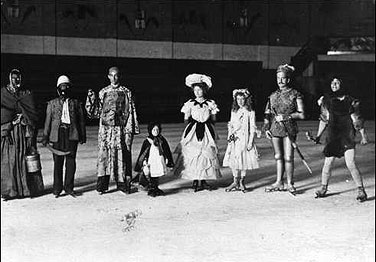
Image below:
Melbourne Glaciarium, c.1952,
Allan Ganter, Jim McLaughlian, Reg Andrews (jump), and Rob Dewhurst.
Image courtesy of IHNSW.
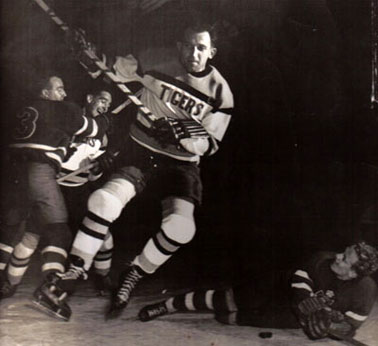
Images below:
Home and Away, Sam Hood, (1872-1953)
Interior of the Sydney Glaciarium Ice Rink, 1940, 849 George Street West, Sydney.
State Library of New South Wales, Frame order no. : Home and Away - 10087

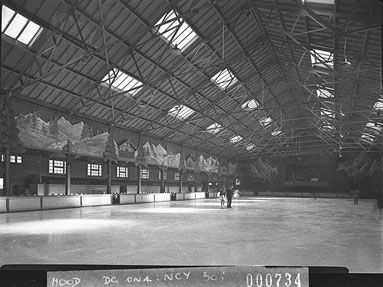
Image below:
Western Suburbs vs St George at Glaciarium, 1937, Sam Hood, (1872-1953)
Sydney Glaciarium Ice Rink, 849 George Street West, Sydney.
State Library of New South Wales, Frame order no. : Home and Away - 15151
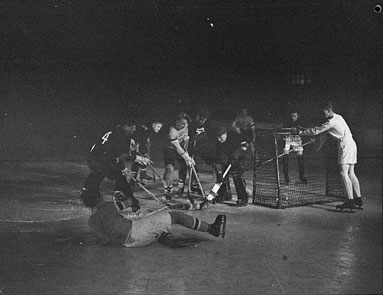
Images below:
Western Suburbs vs St George at Glaciarium, 1937,
Sam Hood, (1872-1953)
Sydney Glaciarium Ice Rink, 849 George Street West, Sydney.
State Library of New South Wales, Frame order no. : Home and Away - 15150 and 15152
